5 Best Legal Project Management Software to Choose From
5 Best Legal Project Management Software to Choose From
Legal work comes with a lot of moving parts, and it’s surprisingly easy for tasks, documents, and deadlines to get out of sync. At some point, most teams realize they need something more organized.
Legal project management software offers a cleaner way to keep everything in order so your cases progress without unnecessary stress.
This guide gives you a straightforward look at the tools that help legal teams stay organized, coordinate work, and manage matters with a bit more breathing room. You’ll see what each platform offers, how it supports daily workflows, and why these systems have become so popular across the legal field.
Let’s walk through the options and find the ones that fit your practice best.
What Is Legal Project Management Software?
Legal project management software brings your tasks, deadlines, case details, and other important information into one organized system.
Many legal professionals use these platforms to keep matters moving without dealing with scattered emails or mismatched notes. Everything sits in a single place, which makes it easier to understand what needs attention and what’s already on track.
These tools help with tasks like:
- Scheduling
- Task assignments
- Progress tracking
- Document sharing
- Team coordination
Law firms often use legal management software to keep workloads balanced and make sure no one loses sight of important steps in a matter. It also supports budgeting, client expectations, and recurring processes that show up in different cases.
Strong legal project management tools give legal teams a clearer view of who’s doing what, how far along each task is, and where timelines might need adjustment. When used correctly, the overall workflow becomes more predictable and easier to manage.
For busy teams handling multiple matters at once, having that structure can make day-to-day work feel smoother and far less chaotic.
Why Should You Be Using Legal Project Management Software?
To reiterate, legal project management software helps legal firms keep matters organized, track moving pieces, and maintain steady progress across cases.
Many attorneys deal with shifting priorities and constant communication, so having a good project management tool gives the entire team a shared system that cuts down on disorganization and manual tracking.
Here’s why these platforms make such a difference in the legal sector:
- Greater visibility across matters: Everyone sees deadlines, task status, and upcoming steps easily.
- Clear task ownership: Legal work moves faster when responsibilities are assigned and easy to follow.
- More predictable schedules: Deadlines, milestones, and reminders help attorneys stay ahead of busy calendars.
- Smoother legal workflows: Routine steps, recurring tasks, and matter stages stay consistent from case to case.
- Better resource planning: Legal practice management software helps teams balance workloads and avoid bottlenecks.
- Improved client service: Organized communication and timely updates naturally raise client satisfaction.
- Fewer manual processes: Centralized information reduces the time spent tracking work in spreadsheets or scattered notes.
Legal teams that rely on structured project coordination often feel more in control of their caseloads, especially when managing multiple matters at once.
Top 5 Legal Project Management Software
Choosing the right platform can shape how smoothly your cases move from start to finish. To help you narrow things down, here’s a quick look at five legal project management tools many teams rely on when they want clearer workflows and better day-to-day organization.
1. PracticePanther
PracticePanther offers a flexible workspace that suits legal departments, small firms, and growing teams managing complex projects.
It brings together tasks, documents, deadlines, and communication so you’re not jumping between different systems to keep matters organized.
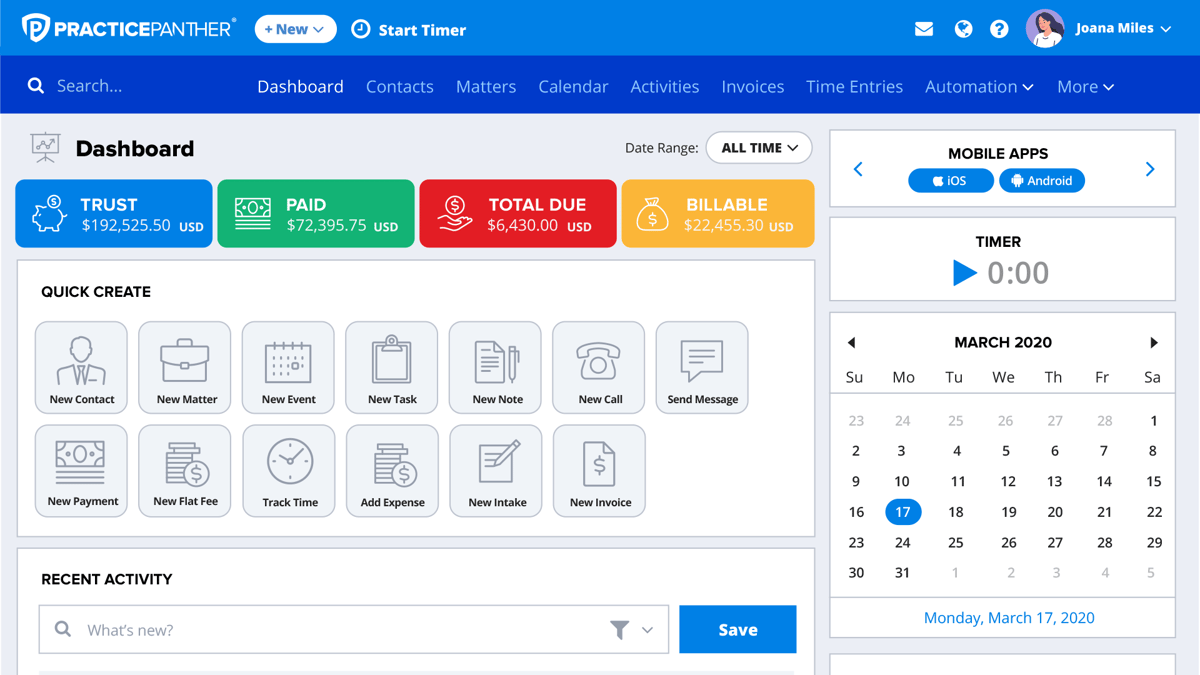
Source: G2
Many legal professionals appreciate that it adapts easily. You can set up project templates, build custom workflows, and shape the platform around how your team already handles legal processes.
The overall feel is structured without being rigid, which helps legal work move with fewer hiccups.
Best Features
- Custom workflows: Build matter stages and automated actions that match your internal steps and support consistent legal workflows.
- Project templates: Create reusable templates for cases you handle often, making it easier to set up new matters with the right structure.
- Document management: Store, manage, and share documents in one place so the entire team always knows where to find key files.
- Task and deadline tracking: Assign tasks, stay ahead of due dates, and follow progress from one dashboard.
- Integrations with other tools: Connect calendars, email platforms, accounting systems, and other tools to keep your workspace connected.
Pros
- Simple setup that helps teams get organized without a long learning curve
- Strong customization options for different practice areas
- Helpful document features for large matters and ongoing projects
- Clear visibility into workloads across the entire team
- Good balance of usability and power for firms in the legal industry
2. MyCase
MyCase offers a more guided way to manage matters, tasks, and communication, especially if your team wants something organized but not overwhelming.
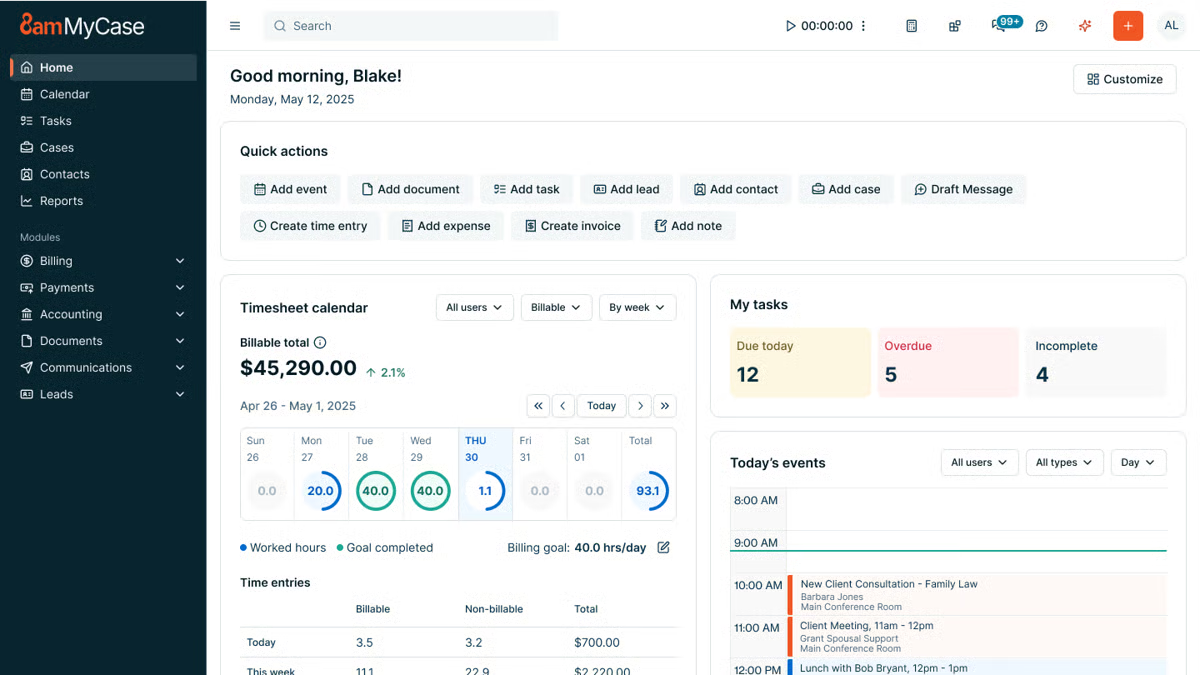
Source: G2
The platform focuses on keeping your work structured from the moment a case opens. It gives you a clear place to track actionable tasks, store legal documents, and stay aligned with your team throughout each matter.
You might like how naturally it supports case management while still giving you project-focused tools that help everyone keep pace with deadlines and daily responsibilities.
Best Features
- Actionable task management: Break down work into clear, trackable steps so nothing gets overlooked.
- Centralized case management: Keep client details, deadlines, notes, and progress in one easy-to-follow system.
- Document storage and sharing: Organize legal documents, research files, and matter-related materials in a single hub.
- Built-in communication tools: Coordinate with your team and clients without relying on outside apps.
- Workflow tools: Use structured steps that help streamline workflows and keep matters moving predictably.
Pros
- Clean interface that enables users to work efficiently
- Reliable document tools for busy practices and small firms
- Helpful law firm communication features for both internal and client updates
- Strong case organization that keeps everything accessible
- Secure platform that supports consistent, organized project work
3. Clio Manage
Clio Manage gives legal teams a structured way to handle matters, track work, and coordinate daily activity without bouncing between multiple systems.
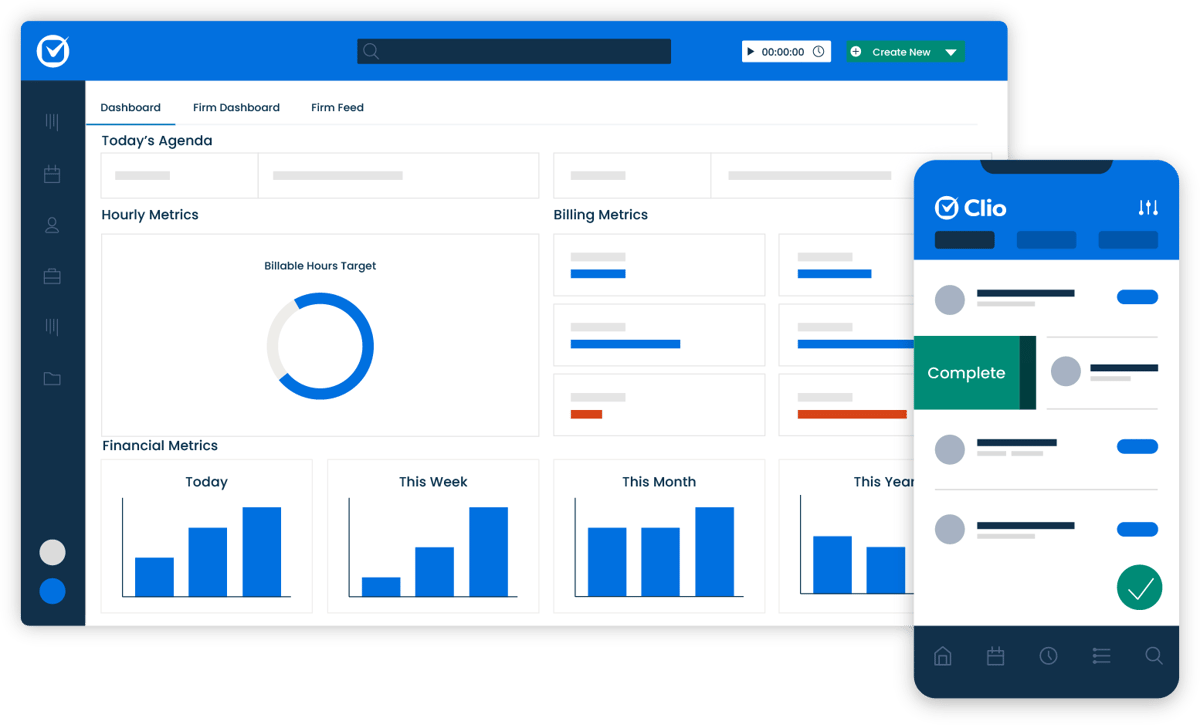
Source: G2
It combines client intake, task management, time tracking, and collaboration tools in one place. With that, your team can always have a steady flow of information as cases progress.
The platform also makes it easy to sync data from your calendar, email, and other apps you rely on, and the real-time dashboards offer a quick read on law firm productivity and upcoming deadlines. It’s a practical setup for teams that want a clearer rhythm to their work.
Best Features
- Client intake tools: Capture new client information smoothly and move it straight into your matters.
- Time tracking: Track billable and non-billable time as you work, with options to log entries from multiple devices.
- Team collaboration: Share updates, assign tasks, and keep the flow of information steady across your team.
- Real-time dashboards: See performance metrics, matter progress, and upcoming deadlines instantly.
- Customizable workflows: Set up processes that match how your firm operates and improve daily efficiency.
Pros
- Strong time tracking for accurate legal billing
- Helpful intake tools that support new client onboarding
- Clear dashboards for quick insight into active matters
- Smooth collaboration across different practice roles
- Easy integrations that keep your data synced and organized
4. Smartsheet
Smartsheet works well for legal teams that want a flexible, spreadsheet-style workspace without feeling stuck in traditional grids. It gives you an easy way to organize tasks, capture information through custom fields, and track progress across matters or internal projects.
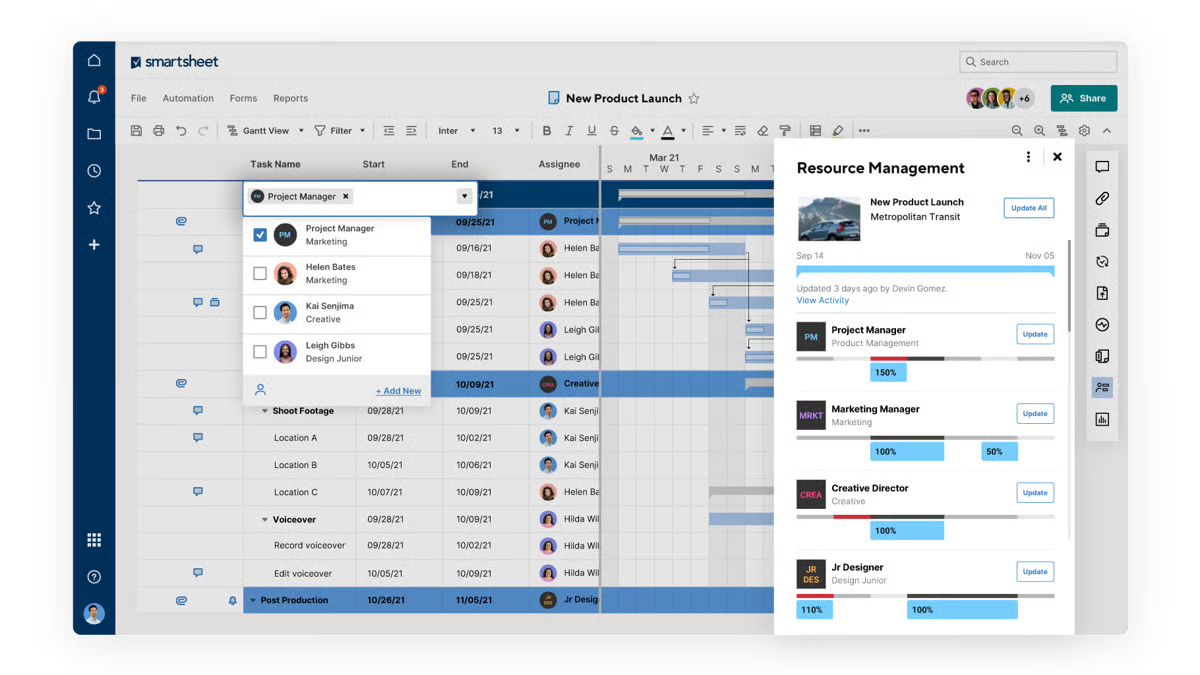
Source: G2
Staff members can add status updates, attach documents, and monitor deadlines in a layout that feels familiar but far more structured than a basic spreadsheet.
It’s often used by legal operations teams that want a clear view of business performance while keeping day-to-day work organized.
Best Features
- Custom fields: Build the exact data structure you need for matters, tasks, or internal processes.
- Status tracking: Follow progress in real time with color-coded updates and clear task ownership.
- Dashboards: Pull together key information to quickly assess workload, deadlines, and priorities.
- Automated alerts: Receive notifications when tasks change, deadlines shift, or updates are added.
- Flexible views: Switch between grid, calendar, Gantt, and card views based on how you prefer to see your work.
Pros
- Familiar layout that’s easy for staff members to adopt
- Strong tracking tools for monitoring progress across multiple projects
- Helpful dashboards for a quick read on business performance
- Good flexibility for teams that juggle different types of work
- Clear status updates that keep everyone aligned on next steps
5. Filevine
Filevine offers a structured workspace that helps legal teams manage cases with fewer scattered updates and a lot more clarity. The platform keeps your tasks, documents, notes, and communication in one place, so important details stay connected as a matter progresses.
Source: G2
Its customization options are a standout, too. You can shape legal workflows, store legal briefs in organized folders, and save notes directly inside each file without losing track of information.
For teams looking to increase productivity and maintain a steady rhythm across their workload, it provides a dependable setup.
Best Features
- Customized workflows: Create processes that match the way your practice handles matters from start to finish.
- Document handling for legal briefs: Keep briefs, case files, and supporting documents neatly organized.
- In-matter notes: Save notes right where they belong so key points are easy to find later.
- Collaboration tools: Share updates, assign tasks, and keep everyone on the same page.
- Reporting tools: Review performance trends and workload insights without manual data gathering.
Pros
- Flexible workflow options suited to different practice areas
- Convenient note-taking inside each matter
- Solid document tools for briefs and related files
- Clear task visibility for smoother team coordination
- Useful reporting for tracking workload and performance
Why Briefpoint Complements the Best Project Management Software
Project management platforms keep your matters organized, but they don’t handle the document-intensive side of discovery and litigation workflows.
Briefpoint fills that gap by generating discovery documents for you, reducing manual drafting, and improving workflow efficiency where legal teams often lose the most time.
And with Autodoc, you get an even smoother lift. It takes the routine formatting, labeling, Bates numbering, and structure-based tasks off your plate. You get cleaner documents, faster turnaround, and a process that feels far more manageable.
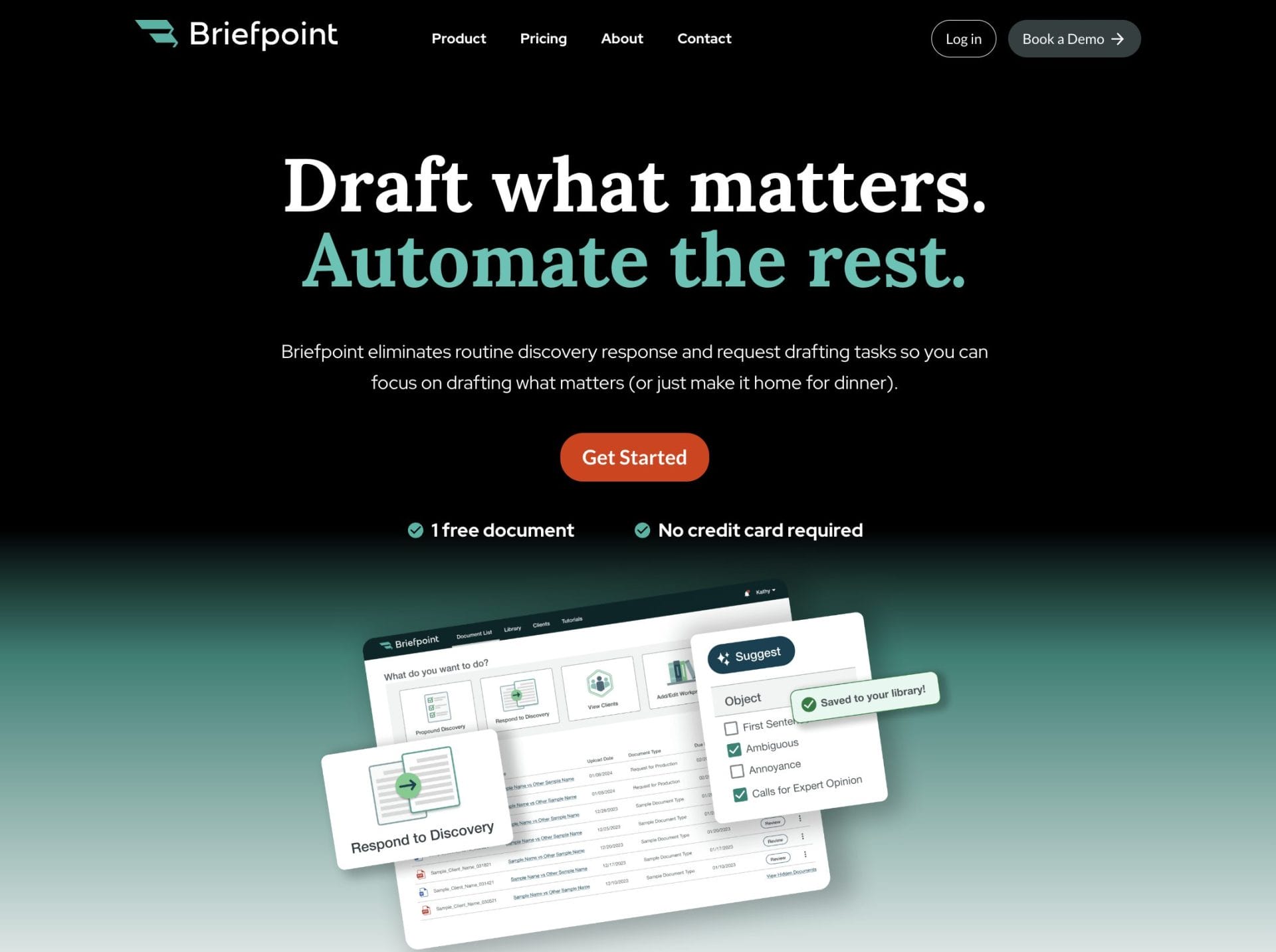
Project tools manage the structure of your work; Briefpoint supports the substance. Together, they give you a smoother path through deadlines, requests, and the back-and-forth that defines discovery.
It’s a practical add-on for teams that want less friction in their document work and a more predictable pace during litigation.
If you’re ready to remove the most time-consuming part of your process, Briefpoint can help you get there.
FAQs About Legal Project Management Software
Who can use legal project management software?
These platforms aren’t just for attorneys. Support staff, paralegals, and anyone involved in case coordination can use them to stay organized and keep information flowing smoothly across the legal field.
How does this software help teams work smarter?
It centralizes tasks, deadlines, documents, and communication so your team avoids duplicate efforts and spends more time on meaningful work like legal research, client updates, and matter strategy.
Does legal project management software help with client communication?
Yes. Clear timelines, progress updates, and well-organized files make it easier to respond to a potential client or an existing one with accurate, timely information.
Do firms need a legal project manager to use these tools?
Not necessarily. A legal project manager can add structure, but most platforms are built so any team can adopt them, manage tasks, and keep cases moving without extra complexity.
The information provided on this website does not, and is not intended to, constitute legal advice; instead, all information, content, and materials available on this site are for general informational purposes only. Information on this website may not constitute the most up-to-date legal or other information.
This website contains links to other third-party websites. Such links are only for the convenience of the reader, user or browser. Readers of this website should contact their attorney to obtain advice with respect to any particular legal matter. No reader, user, or browser of this site should act or refrain from acting on the basis of information on this site without first seeking legal advice from counsel in the relevant jurisdiction. Only your individual attorney can provide assurances that the information contained herein – and your interpretation of it – is applicable or appropriate to your particular situation. Use of, and access to, this website or any of the links or resources contained within the site do not create an attorney-client relationship between the reader, user, or browser and website authors, contributors, contributing law firms, or committee members and their respective employers.
Everlaw vs. Relativity: How They Really Compare
Everlaw vs. Relativity: How They Really Compare
Choosing discovery software can feel like a big decision, especially when you’re comparing platforms that all claim to improve your workflow.
It helps to start with a clear view of what each tool actually does and how those differences affect the way your team works day to day.
Your purchasing decisions shouldn’t rely on guesswork, and understanding the innovation created by each platform gives you a better sense of which one you might ultimately select.
With that in mind, this guide walks you through Everlaw, Relativity, and Briefpoint so you can see how they compare in purpose, features, onboarding, and overall value.
What Is Everlaw?
Everlaw is a cloud-based eDiscovery software provider that helps legal teams search, organize, and review large sets of electronic documents in a single platform.
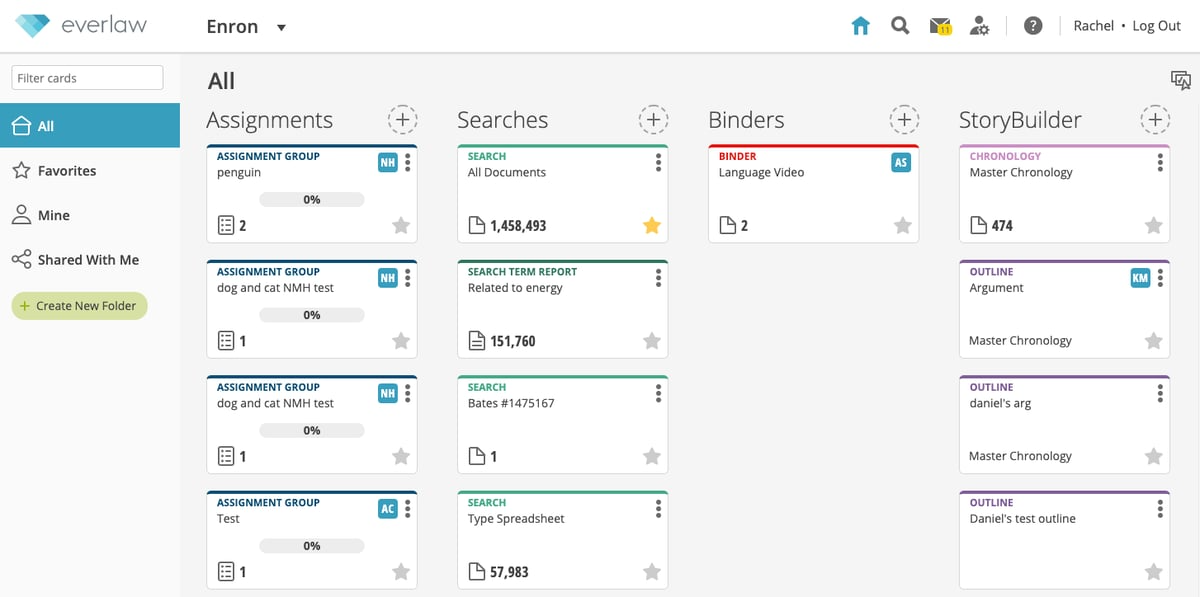
Source: G2
Essentially, it supports the full document review process and gives teams a way to move through big data collections without feeling buried in files.
Many users appreciate that Everlaw feels approachable, runs searches quickly, and offers a layout that doesn’t require weeks of training. In comparisons built on real user data, focused insights, and detailed feature ratings, it often stands out for ease of use and overall review speed.
What Is Relativity?
Relativity is one of the most widely known eDiscovery software platforms, often used for large or complex matters that call for advanced search, analytics, and review controls.
The platform gives legal teams a structured way to handle big data collections, run detailed searches, and manage document review from start to finish.
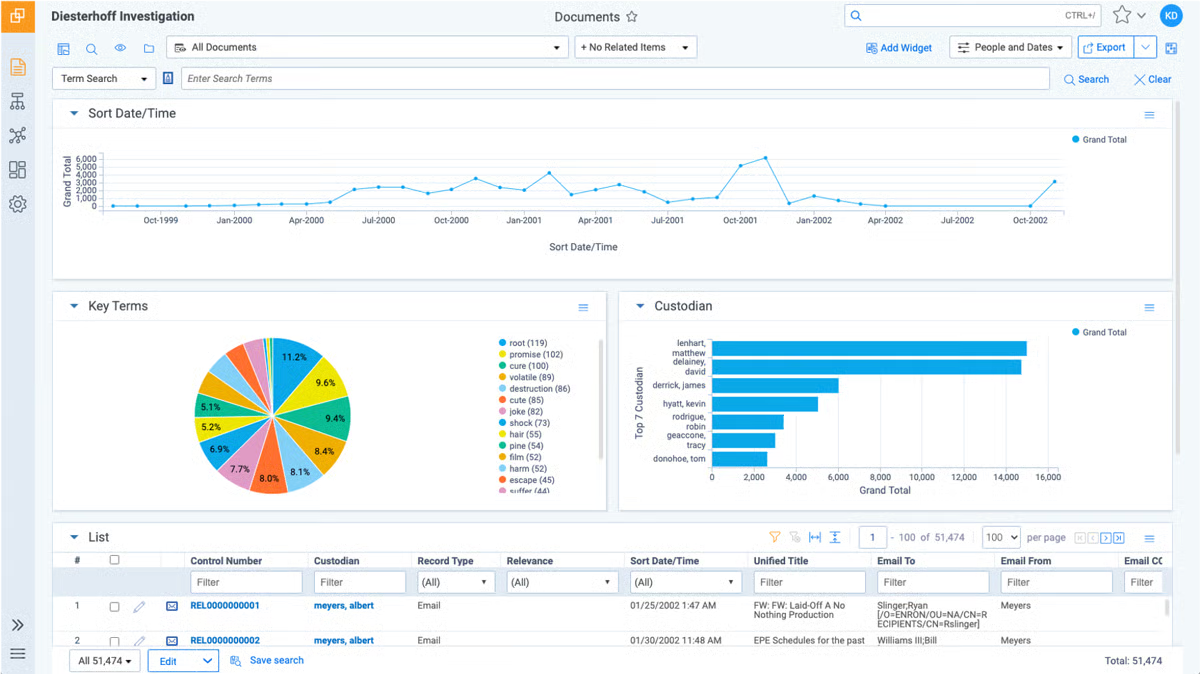
Source: G2
Many organizations rely on Relativity because it supports deep customization and integrates well with existing legal workflows. Reviews that measure user satisfaction often include multiple data points tied to performance, ease of use, and individual vendor capabilities.
Some industry reports even aggregate emotional response ratings to produce a net emotional footprint, which helps understand the overall contract experience created through real usage.
What Is Briefpoint?
Briefpoint is an AI-powered document automation platform built to help litigation teams draft and serve discovery way faster than traditional methods.
It covers the full workflow for propounding and responding to discovery and gives firms a way to surface key elements across large sets of case files without hours of manual review.
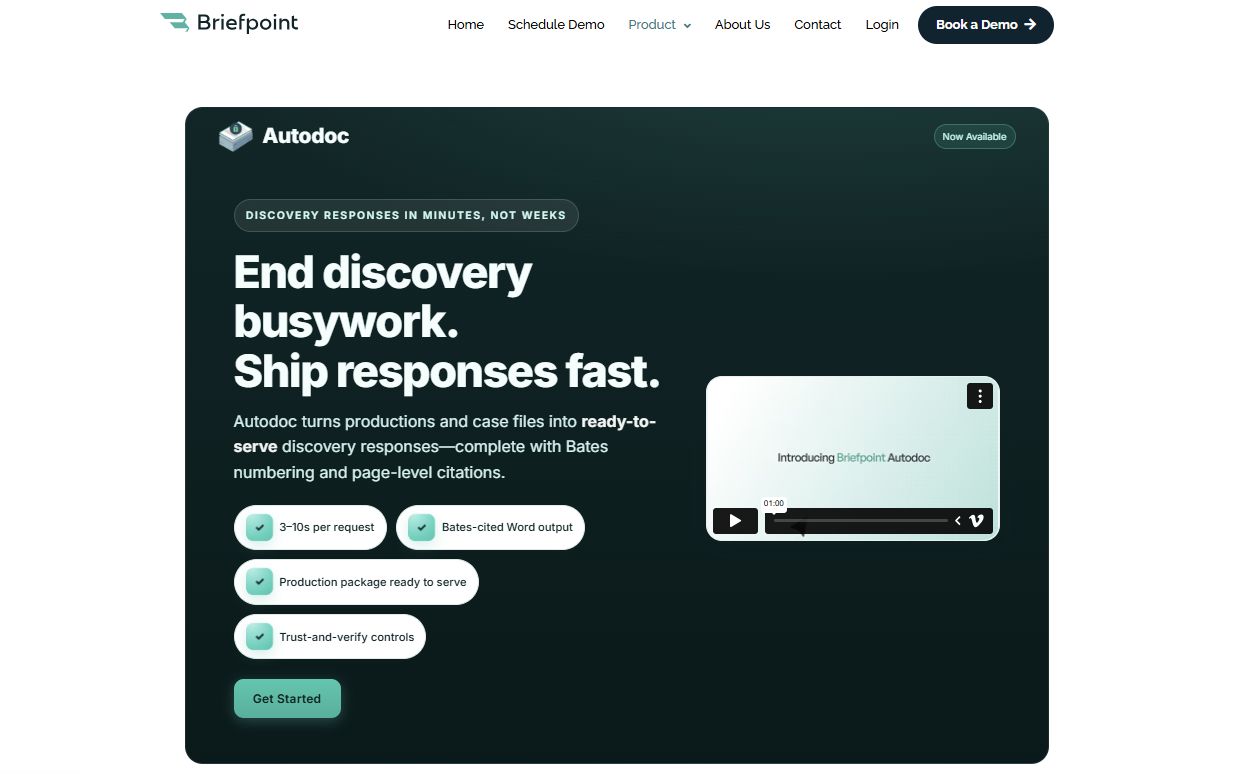
An important element of the platform is Autodoc, Briefpoint’s module that turns productions and case files into fully formatted, Bates-cited discovery responses in minutes. Autodoc handles the heavy lifting that many teams struggle with.
Upload the complaint, requests for production, and case files. Then, the system identifies responsive materials, maps them to each request, and generates Word-ready responses along with a Bates-numbered production package.
The trust-and-verify controls give reviewers clarity into where the tool searched and what it found, which allows teams to work through high-level metrics quickly while keeping full control before service.
Briefpoint as a whole goes beyond single-task automation. It propounds discovery from complaints, drafts objection-aware responses, supports client response collection, and offers a secure, structured workflow that many firms use as their central discovery hub.
Everlaw vs. Relativity vs. Briefpoint: The Key Differences You Should Know
Shopping for discovery tools can feel like a lot, especially when each platform claims to solve the same problems. This quick comparison gives you a clear view of what each one focuses on, so you can decide which direction makes the most sense for your workflow.
Main Purpose
Everlaw, Relativity, and Briefpoint each focus on a different part of the discovery process. That’s why it should be easier to see where they fit once you look at their core goals.
Everlaw centers on fast search, clear organization, and document review. Its main goal is to give legal professionals a way to sort through large data sets without feeling overloaded.
Relativity leans into customization. Teams that need flexible workflows or integrations often choose it because its particular product offerings can support complex, specialized projects.
Briefpoint focuses on drafting, responding, and producing discovery. Its document automation helps firms move from raw case files to finished work product quickly, which creates real business value for anyone who wants fewer manual steps and shorter turnaround times.
This approach saves hours (30+ per case) and produces cleaner deliverables.
Overall, each platform typically delivers benefits in different parts of the workflow, which gives you a straightforward way to decide which potential partners align with your priorities.
Best Features
Here’s a quick look at the strengths each platform brings to the table. This breakdown gives you a simple way to compare what matters most across the three lawyer tools.
Everlaw Best Features
- Fast search across large data sets: Runs quick queries across your entire database to help teams find what they need without delays.
- Visual review tools: Give reviewers a clear path through documents with timelines, notes, and simple navigation.
- Collaboration features: Let teams comment, tag, and share insights to keep everyone aligned.
- User-friendly layout: Designed to lower the learning curve for legal professionals who want clean, simple workflows.
- High-level metrics: Offers reporting that helps teams compare high-level metrics across matters.
Relativity Best Features
- Deep customization: Supports advanced workflows for teams that want to tailor features to case needs.
- Analytics and predictive coding: Helps prioritize legal documents and spot patterns early in review.
- Robust integrations: Works well with other systems used by large organizations.
- Detailed end-user information: Provides activity tracking and logs that support defensible processes.
- Proprietary evaluation methodology: Backed by industry reviews that measure overall user sentiment and long-term satisfaction.
Briefpoint Best Features
- Autodoc for drafting and production: Turns case files into Bates-cited Word responses and production packages in minutes.
- Objection-aware drafting: Generates clean, consistent discovery documents that reduce manual edits.
- Client response collection: Translates interrogatories into plain English so clients answer faster.
- Full eDiscovery workflow: Covers both propounding and responding, which offers more than strong features alone by removing entire steps.
- Significant impact on workload: Cuts hours of manual drafting, which strengthens the vendor-client relationship and simplifies conflict resolution created during busy cases.
- Plain-language client tools: Make client input faster, more accurate, and easier to manage across busy matters.
- Structured verification controls: Shows exactly where Autodoc searched, so teams keep full control before service.
Who It’s Best For
Everlaw works well for teams that want a simple user interface, fast search, and a review environment that feels easy to pick up.
It’s a good fit for firms that want an eDiscovery platform focused on organization and clarity rather than deep customization. If your priority is review efficiency and quick onboarding, Everlaw usually fits that profile.
On the other hand, Relativity suits teams that handle complex matters, need flexibility, or rely on workflows that involve multiple aspects of data management.
Larger firms and litigation groups often choose it because they want a comprehensive overview of case activity and a granular comparison of product effectiveness across different projects.
Basically, many organizations look at Relativity when software satisfaction depends on customization and structured controls.
Briefpoint is ideal for firms that want fast drafting, consistent responses, and a smoother path from raw documents to finished work product. The service experience created through Autodoc appeals to teams that need reliable turnaround times and fewer manual steps.
Briefpoint works especially well for practices that want legal automation across propounding, responding, and client response collection.
If your goal is speed, accuracy, and a tool that completes the work most platforms leave to the user, Briefpoint is often the most practical choice.
Learning Curve and Onboarding
Getting a new platform into your workflow should feel manageable, not overwhelming, so it helps to understand how each tool handles those first few days.
Everlaw is usually the easiest starting point for most legal teams. The layout feels familiar, the core actions are clear, and users often move through the basics without formal training.
Relativity asks for more time and planning. The platform gives you a lot of control, which means onboarding becomes a deeper process. Teams usually benefit from guided setup or internal admins who can configure workspaces and permissions.
This style works best for firms that want power and flexibility and don’t mind a longer path before everything feels natural.
Meanwhile, Briefpoint focuses on quick adoption. Uploads, drafting steps, and Autodoc workflows follow a simple sequence, so new users usually build confidence within minutes.
Many teams describe the customer experience as smooth because they can test real cases almost immediately.
A comprehensive assessment of all three tools shows that onboarding influences user feelings in the early stages, and understanding prior team habits helps you choose a platform that aligns with your expectations for continuous improvement and overall software performance.
What Briefpoint Offers That Everlaw and Relativity Don’t
Each platform brings something different to the table, but the real question is which one actually solves the problems your team deals with every week.
Everlaw helps with straightforward review, and Relativity supports complex, highly customized projects, but neither finishes the legal drafting or production work that usually eats up the most time.
If your goal is faster turnaround, fewer manual steps, and clear work product from the start, Briefpoint stands out as the option that reshapes the entire experience.

Briefpoint handles the part of discovery most platforms leave behind: getting from raw documents to ready-to-serve responses.
Autodoc, objection-aware drafting, and client response tools give you immediate wins, and the service experience created across the workflow helps teams move faster with less stress.
So ask yourself: which tool gives you time back, not just more features to manage? For many teams, that makes the answer obvious.
Book a demo to see how Briefpoint can support your practice.
FAQs About Everlaw vs. Relativity
Is Everlaw a good company?
Everlaw is a well-known software vendor in the eDiscovery space, and many teams view it as reliable for review work. High-level user sentiment from public feedback shows that people often like its speed and clean interface. The information collected illustrates that most users view the platform as approachable, especially for teams that want fast search and organized review.
What is the best eDiscovery software?
The best choice depends on your workflow. Everlaw and Relativity typically deliver strong review and data-management capabilities, while Briefpoint covers the drafting and production side and covers major gaps that other platforms leave out. For a prospective buyer who wants automation and finished work product quickly, Briefpoint often becomes the most practical option.
Is RelativityOne legit?
Yes. RelativityOne is widely used, especially in larger matters. Users often mention that detailed metrics and reporting help them evaluate case progress and understand interactions created across teams. The platform supports complex workflows, which appeals to organizations that want structure and control.
How do users feel about the vendor relationship with these tools?
Feedback suggests that experiences vary. Some teams want simple onboarding, while others want direct support for advanced setups. Reviews touching on next overall feature satisfaction and next conflict resolution often highlight how quickly vendors respond to questions and how smooth the long-term relationship feels.
Which platform has the best user satisfaction?
User satisfaction depends on priorities. Everlaw earns positive notes for ease of use, Relativity for flexibility, and Briefpoint for product effectiveness and speed. If your focus is fast drafting and clear deliverables, Briefpoint often receives the strongest comments.
The information provided on this website does not, and is not intended to, constitute legal advice; instead, all information, content, and materials available on this site are for general informational purposes only. Information on this website may not constitute the most up-to-date legal or other information.
This website contains links to other third-party websites. Such links are only for the convenience of the reader, user or browser. Readers of this website should contact their attorney to obtain advice with respect to any particular legal matter. No reader, user, or browser of this site should act or refrain from acting on the basis of information on this site without first seeking legal advice from counsel in the relevant jurisdiction. Only your individual attorney can provide assurances that the information contained herein – and your interpretation of it – is applicable or appropriate to your particular situation. Use of, and access to, this website or any of the links or resources contained within the site do not create an attorney-client relationship between the reader, user, or browser and website authors, contributors, contributing law firms, or committee members and their respective employers.
What Is Legal Software? (Types, Benefits, & Tips)
What Is Legal Software? (Types, Benefits, & Tips)
Legal work can be demanding enough without tools that slow you down. The right software should simplify daily tasks and keep your firm organized while improving your workflow.
Legal software includes all the tools law firms and legal professionals use to manage their work efficiently; everything from billing and research platforms to full case and discovery management systems.
You may have seen guides on legal software for small law firms, but today’s options go far beyond that. They’re built for practices of every size, including corporate legal departments and multi-office firms.
In this article, we’ll look at the main types of legal software, what they do, and how the right setup can give your firm a better way to operate.
Legal Software Explained
Legal software is a broad term that covers the many tools law firms and legal professionals use to manage their work. It’s too wide-ranging to have one precise definition because it includes everything from legal research tools to full-scale case management systems.
Legal software programs are designed to make daily legal work faster, more organized, and easier to manage. They help with everything, including tracking deadlines, storing documents, reviewing discovery data, communicating with clients, and so much more.
For most law firms, these tools form the backbone of modern legal operations. They replace stacks of paper files with searchable databases, connect teams across departments, and simplify tasks that once took hours.
Whether you’re a solo attorney or part of a large firm, having the right software setup can reshape how efficiently you work.
7 Types of Legal Software
Legal software comes in many forms, each built to handle a different part of running a law firm. Here are the main types of tools legal professionals rely on to manage their daily work efficiently.
1. Law Practice Management Software
Legal practice management software is perhaps the most common type of law firm software. While not every firm has a complete tech stack, nearly all use some version of this system to organize their work.
This kind of software acts as a centralized system. It allows legal professionals to manage clients, cases, documents, calendars, and billing in one place. In other words, it ties together key legal processes, so attorneys can spend less time on administration.
Common features include:
- Client and case management
- Time and expense tracking
- Document storage and organization
- Calendar and deadline management
- Integrated billing and invoicing
- Secure client communication portals
- Reporting and performance dashboards
Modern legal practice management software often connects with tools for email, accounting, and cloud storage. This creates a single workspace that keeps everything in sync. For growing firms, this structure helps maintain consistency and supports smoother collaboration across teams.
2. Legal Case Management Software
Case management software focuses specifically on managing the details of each legal matter. Generally, it offers more depth than general law practice management tools.
While legal practice management software organizes the overall operations of a firm, legal case management platforms handle the finer points of active cases, such as deadlines, filings, communications, and evidence, in a centralized location.
You can think of it as the project management side of a legal practice. It keeps every case moving efficiently by tracking progress, assigning tasks, and maintaining complete records of what’s been done and what’s next.
Many systems also connect to document management and billing tools for a seamless workflow.
Other common features include:
- Matter management and case tracking
- Task and project management tools
- Centralized document and correspondence storage
- Automated deadline and hearing reminders
- Customizable case templates and workflows
- Collaboration tools for teams and clients
- Secure access controls and audit trails
Case management software helps firms of all sizes stay organized and consistent across multiple cases. It ensures that everything lives in one secure space, so it’s easier for attorneys and staff to coordinate efforts and maintain accountability.
3. Legal Billing Software
Legal billing software is designed specifically for how law firms operate. General billing tools can handle invoices and payments, but they often miss key features tied to billable hours, trust accounting, and client-specific reporting.
With this kind of legal tech, firms can track time, record expenses, and send invoices from one secure platform. Plus, it captures every billable minute, links it to the right matter, and helps with collecting payments faster through online billing or automated reminders.
Meanwhile, built-in financial reporting gives partners a clear view of cash flow, outstanding balances, and overall firm performance. This can help drive increased revenue and smarter decision-making.
For example, a small litigation firm might use billing software to automatically track time spent drafting motions or attending hearings.
When the work is done, the software generates an itemized invoice that complies with client billing guidelines. Clients can pay directly through a secure portal, while the system updates the firm’s records instantly.
Automation like this can save hours each week and eliminate manual errors, which, in turn, can give attorneys more time to focus on their cases and clients.
4. Legal Research Tools
Legal research tools make finding information faster and far less frustrating. Instead of digging through endless books or tabs, you can search for legal data in one organized place.
These platforms also use legal technology to sort, filter, and connect information that would otherwise take hours to piece together.
Many law societies now recommend or provide access to these tools because they help lawyers work more efficiently and confidently. They also reduce the risk of missing key precedents or recent updates that could affect a case.
The right legal software depends on what you do. If your focus is on the litigation process, you’ll want tools that highlight case histories and judgments. If you work in corporate law, access to regulatory databases might matter more.
Either way, research tools simplify complex searches and make it easier to back your arguments with the strongest sources available.
5. eDiscovery Software
eDiscovery software helps law firms manage the growing amount of digital evidence involved in modern cases. It’s a software solution built for data management, giving many lawyers the ability to collect, process, and review massive sets of information efficiently and accurately.
Electronically stored information (ESI) often includes:
- Emails
- Documents and PDFs
- Spreadsheets
- Instant messages and chat transcripts
- Audio or video recordings
- Databases or archives
These tools organize, search, and filter ESI so you can identify what’s relevant faster. Automated review features increase efficiency and cut down on repetitive manual work, which saves valuable time during the discovery process.
6. Document Management Software
Document management software keeps every file in one organized, secure place. In the legal industry, it’s the go-to tool for storing and managing client intake documents, contracts, and other case materials.
Legal teams and legal departments often deal with thousands of Word documents, PDFs, and scanned files each month. With version control, everyone can see who made edits, when they happened, and which file is current. That keeps collaboration smooth and prevents mix-ups.
Data security is another major benefit. Built-in encryption and reliable data storage protect sensitive client information from leaks or accidental deletion.
7. Communication Tools
Every law firm runs on communication, and the right tools make it much easier to keep everyone on the same page.
Modern platforms bring messaging, meetings, and file sharing into one space. This way, legal teams, staff, and key stakeholders can stay connected without chasing emails or switching apps.
Look for collaborative features that fit the way your team works, such as:
- Secure chat and video calls for quick discussions
- Shared calendars to keep track of deadlines and meetings
- Task boards for assigning and monitoring work
- File sharing linked to cases or matters
- Client portals that make communication and document exchange simple
These law firm communication tools support internal coordination and help strengthen client relationships. Clients appreciate having a secure, convenient place to check updates or send documents when needed.
If your firm’s operations feel scattered across too many channels, a unified communication system can pull everything together.
What Kind of Tech Stack Do You Need?
Not sure what kind of tools your team needs? Here’s how to choose the best legal software for your team and make it blend seamlessly with your existing software and internal processes.
Start With Core Management Tools
Every firm needs a strong foundation for handling cases, clients, and legal documents. So, start with practice and case management software that keeps everything in one place. A solid core system sets the stage for better coordination across the firm.
Add Billing and Accounting Integration
Financial accuracy matters just as much as legal accuracy. Integrating billing and accounting software reduces errors and saves time on administrative tasks.
Plus, automated invoicing, time tracking, and trust accounting can improve cash flow and make financial reporting more transparent.
Use Automation to Save Time
Firms that automate legal processes gain hours back every week. Workflow automation tools that auto-fill forms, schedule reminders, or generate reports reduce repetitive work so your team can focus on delivering high-quality legal services.
Even simple automation, like client intake forms or document templates, can have a big impact.
Choose a Platform That Works Together
Your software platform should integrate smoothly with the tools you already use. Disconnected systems slow everyone down, while connected ones keep information flowing easily between case files, billing, and communication tools.
Focus On Growth and Usability
The best tech stack scales with your firm. Choose tools that are easy to learn, flexible to customize, and secure enough to handle expansion.
A well-structured system not only improves daily efficiency but also boosts your firm’s productivity and creates measurable key benefits, like faster turnaround times and better collaboration.
What Are the Benefits of Good Legal Software?
Whether you’re part of a large team or one of many solo practitioners building a client base, the right tools can take pressure off the most time-consuming tasks so you can focus on actual legal work.
Here’s what you can expect:
- Better efficiency: Routine work like billing, scheduling, and document prep runs automatically, which can give you back hours every week.
- Stronger organization: Everything lives in one secure, searchable space.
- Tighter security: A reliable software provider protects client data with encryption and controlled access, so sensitive files stay private.
- Smoother collaboration: Whether you’re working with colleagues or clients, shared access keeps everyone on the same page without endless email threads.
- Room to grow: Scalable tools adapt as your caseload or team expands, so you never outgrow your setup.
- Clearer insight: Reporting tools reveal patterns in performance, billing, and law firm productivity, to help you make smarter business decisions.
Why Briefpoint Belongs in Your Legal Toolkit
How much time do you spend drafting the same types of documents? How often do late nights come from repetitive work that software could handle in minutes?
That’s the reality many lawyers face and the reason tools like Briefpoint exist.
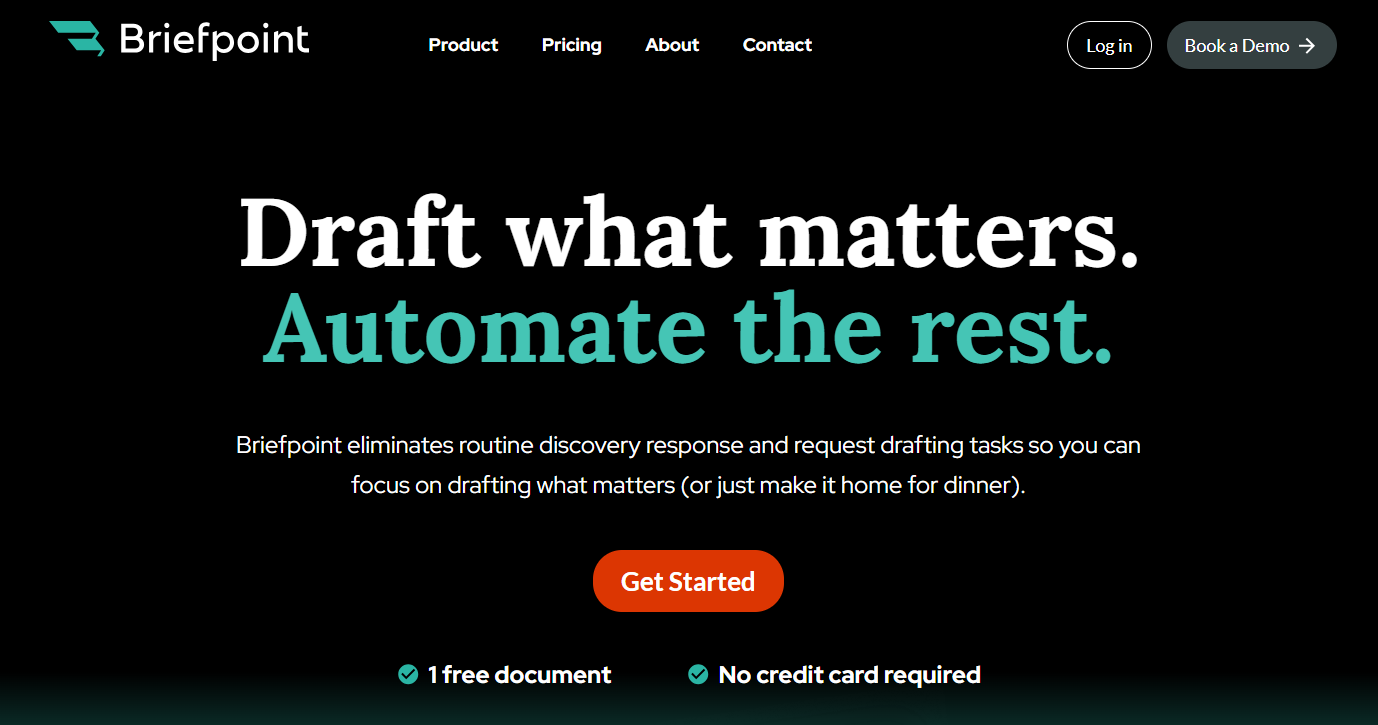
With Briefpoint and its new Autodoc feature, you can cut weeks of manual review, formatting, and Bates labeling down to minutes, all while keeping full control and transparency over your work.
Autodoc automatically finds responsive documents, generates Bates-cited Word responses, and packages productions that are ready to serve.
Curious what that looks like in practice? Book a demo with Briefpoint now
FAQs About What Is Legal Software
Which legal software is the best?
The best law firm software depends on your firm’s size, practice area, and goals. Some firms prefer all-in-one platforms that handle billing, case management, and communication, while others choose specialized tools for research or discovery. The key is choosing software that supports productivity and improves client satisfaction.
What is the legal definition of software?
In a legal context, software refers to a set of coded instructions that perform specific tasks on a computer or system. Legal software applies this idea to law-related work, helping attorneys manage documents, automate tasks, and organize cases more efficiently.
What is legal software called?
Legal software can fall under several names depending on its purpose: case management systems, eDiscovery tools, or practice management platforms, for example. Most modern tools now include artificial intelligence to process data and predict patterns that support decision-making.
How much does legal software cost?
Pricing varies widely based on features and user count. Some new software options start at under $100 per user per month, while enterprise-level systems can reach several hundred thousand dollars. The right investment can strengthen workflows, improve collaboration, and directly impact your firm’s success as new technology continues to evolve.
The information provided on this website does not, and is not intended to, constitute legal advice; instead, all information, content, and materials available on this site are for general informational purposes only. Information on this website may not constitute the most up-to-date legal or other information.
This website contains links to other third-party websites. Such links are only for the convenience of the reader, user or browser. Readers of this website should contact their attorney to obtain advice with respect to any particular legal matter. No reader, user, or browser of this site should act or refrain from acting on the basis of information on this site without first seeking legal advice from counsel in the relevant jurisdiction. Only your individual attorney can provide assurances that the information contained herein – and your interpretation of it – is applicable or appropriate to your particular situation. Use of, and access to, this website or any of the links or resources contained within the site do not create an attorney-client relationship between the reader, user, or browser and website authors, contributors, contributing law firms, or committee members and their respective employers.
5 Bates Numbering Software Options For The Legal Industry
5 Bates Numbering Software Options For The Legal Industry
Bates numbering has been part of legal work for decades. What began as a manual stamping method is now handled through software that can number thousands of pages in seconds.
For law firms, the ability to assign unique identifiers to every page isn’t optional. It’s how teams keep cases organized and easy to reference.
Bates numbering software takes this process digital. It applies page numbers, prefixes, or codes to entire document sets. This, in turn, makes it simple to cite evidence, share files, and stay consistent across a case.
The shift from stamping machines to automated tools means less time spent on repetitive tasks and fewer mistakes in production.
In this article, we’ll explain what Bates numbering tools are, why they’re valuable for legal teams, and which programs stand out in 2025.
What is a Bates Numbering Tool?
A Bates numbering tool is software used to add unique identifiers, called Bates numbers, to pages in PDF documents. This process, sometimes known as Bates stamping, helps legal teams keep thousands of pages organized and easy to reference.
So, instead of flipping through stacks of paper, legal professionals can quickly locate the exact page they need during discovery, trial, or client work.
With a Bates numbering tool, you can apply custom numbers, prefixes, suffixes, or dates to each page, which makes it simple to track documents across a case. The numbers are placed digitally, so you can edit, batch-process, and format them as needed.
Key features include:
- Adding sequential Bates numbers to large sets of legal documents
- Using custom numbers like client codes or case IDs
- Choosing the placement of numbers on the page (top, bottom, left, right)
- Batch numbering across multiple PDF documents at once
In short, a Bates numbering tool saves time, reduces errors, and gives law firms a reliable system to reference every page in their files.
Let’s take a closer look at the advantages you can expect.
What Are the Benefits of Bates Numbering Software?
Managing thousands of PDF pages can get overwhelming, especially when working on discovery or preparing evidence.
Bates numbering software helps by giving you an easy, intuitive way to add Bates numbers across a single document or even multiple PDF files at the same time.
So, rather than manually stamping every page, you can apply consistent numbering in just a few clicks.
Here are some key benefits:
- Save time: Number large sets of documents in minutes instead of hours.
- Stay accurate: No skipped pages or duplicate numbers thanks to automatic sequencing.
- Customize the format: Adjust the numbering format, add prefixes or suffixes, and adapt to your specific needs.
- Batch processing: Apply numbering to multiple PDF files at once or just a single document.
- Better organization: Clear numbering makes it simple to follow and reference files during legal work.
- Professional results: Clean, uniform stamping that shows preparation and attention to detail.
With these features, Bates numbering software makes it much easier to organize case files, customize numbering, and keep everything consistent across your documents.
5 Best Bates Numbering Software As of 2025
Now that we’ve covered the main benefits of using Bates numbering software, the next step is choosing the right tool. Not every program offers the same features. Some are built specifically for legal professionals, while others are general PDF tools with Bates stamping added in.
To help narrow it down, here are five of the best options in 2025, each with its own strengths depending on your specific needs.
1. Briefpoint Autodoc
Briefpoint Autodoc is changing how litigation teams handle discovery.
For years, lawyers and paralegals have spent countless hours reading through productions, tagging documents, drafting responses, and then manually applying Bates numbers. The process is slow, expensive, and prone to human error.
Autodoc presents a solution to this by automating every step.

Instead of assigning staff to review thousands of PDF pages, you upload your production set along with the RFPs. Autodoc then scans the production tree, finds responsive documents, and drafts complete responses with Bates stamping and page-level citations already in place.
In less than 10 seconds per request, you have a finished, court-ready package: the written responses, the Bates-stamped production, and the citations that tie it all together.
The difference is dramatic. Tasks that once took weeks of manual work are compressed into a single upload. That means your team spends more time on case strategy and less time on repetitive, error-prone discovery tasks.
Key Features
- Automated RFP drafting: Instantly generates responses to every request for production.
- Bates numbering: Applies consistent Bates numbers across productions with no manual stamping.
- Page-level citations: Links each response to the exact Bates-stamped page for defensible accuracy.
- Batch processing: Handles thousands of documents at once, not just a single file.
- One-click packaging: Produces a ready-to-serve response and production set in minutes.
- Speed: Delivers drafts in 3–10 seconds per request to replace weeks of manual review.
For litigation teams, Autodoc is a discovery automation engine. It handles the grunt work so your team can focus on higher-level tasks like building arguments and advising clients.
Join the waitlist for Autodoc to secure early access. If you want to see the core software, book a demo with Briefpoint to see how the platform can transform your discovery workflow.
2. UPDF
UPDF is a versatile PDF editor that includes a reliable Bates numbering function. Unlike a heavy suite that may feel overwhelming, UPDF works well as a stand-alone program for firms that need both general PDF editing and numbering tools.
Essentially, it’s designed to handle large volumes of files, which makes it useful for discovery documents or compliance tasks where thousands of pages need to be marked with a page number.
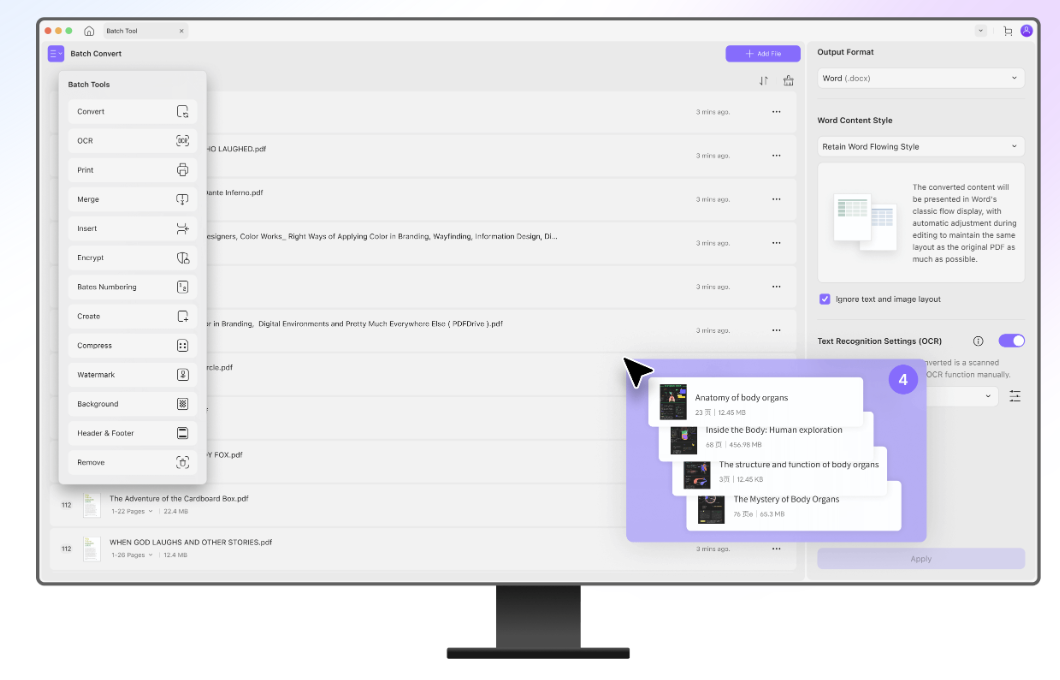
Source: UPDF.com
The software balances ease of use with advanced features, giving users the ability to edit, annotate, merge, and secure documents in addition to numbering them.
Key Features
- Batch Bates numbering: Apply numbering to multiple files at once, saving time on large projects.
- Custom numbering format: Add prefixes, suffixes, or case IDs to match legal requirements.
- Flexible placement: Choose where the page number appears (top, bottom, left, right).
- PDF editing tools: Annotate, merge, and convert PDFs alongside numbering.
- Cross-platform access: Available on Windows, Mac, iOS, and Android.
- Download options: Subscription or lifetime license available.
3. Adobe Acrobat DC
Adobe Acrobat DC is one of the most recognized PDF solutions, widely used by legal professionals and corporate teams. It includes a dependable Bates numbering feature that makes it simple for users to mark documents with a consistent index.
And because many firms already use Acrobat for editing and review, it often serves as the default choice for Bates stamping.
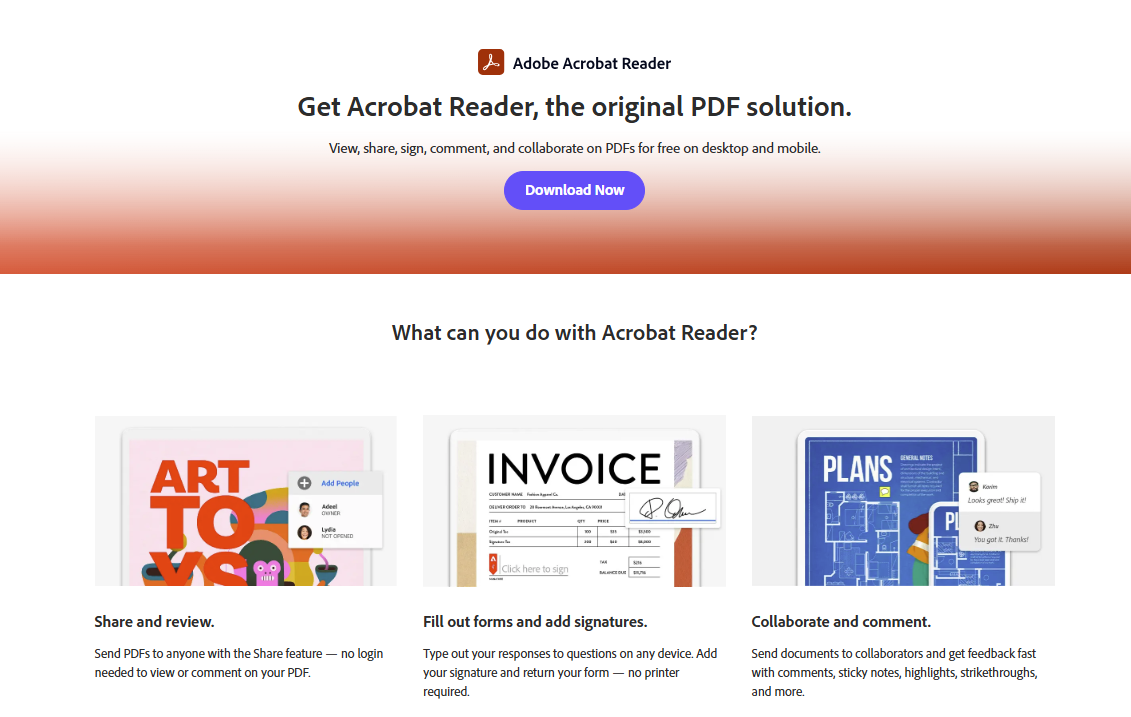
Source: Adobe.com
Acrobat DC is designed to work across different computers and operating systems, which allows teams to collaborate on the same files regardless of their setup. Beyond numbering, it offers tools to edit text, redact sensitive information, and sign files digitally.
The platform also provides options to modify numbering as needed. Users can reset sequences, add prefixes, or adjust placement without reprocessing the entire document.
With its advanced editing suite and integrations, Acrobat DC is suitable for handling large volumes of PDFs where organization and compliance are key.
Key Features
- Bates stamping: Apply sequential numbering across one or many files.
- Custom index format: Add prefixes, suffixes, or adjust number sequences.
- Modify settings: Change placement, font, or numbering without redoing the file.
- Advanced editing tools: Redaction, OCR, and e-signatures included.
- Cross-device use: Works across different computers and platforms.
- License options: Subscription-based pricing for individuals or teams.
4. Aryson PDF Bates Numbering Tool
Aryson PDF Bates Numbering Tool is a dedicated program built specifically for applying Bates numbers to PDFs. Rather than serving as a general editor, it focuses on numbering functions that legal professionals need during discovery and review.
Plus, it can process multiple PDFs at once and gives users full control over numbering details such as prefix, suffix, and starting number.
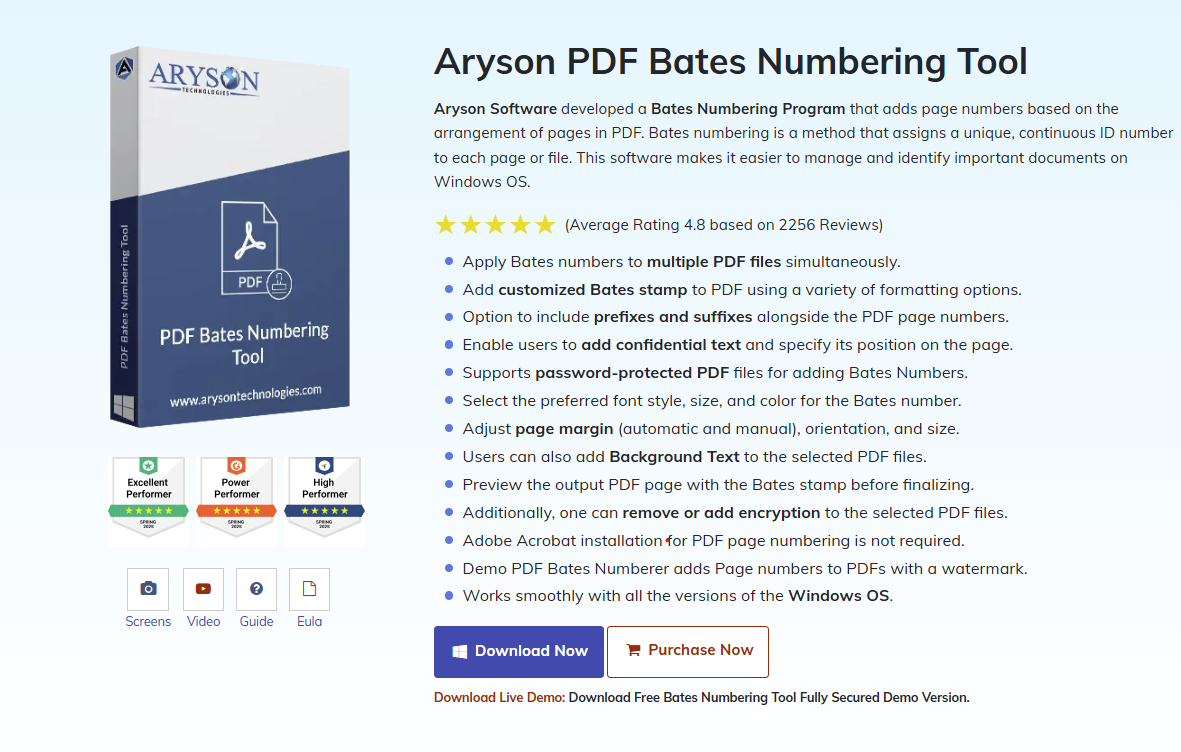
Source: ArysonTechnologies.com
The software is easy to install and use, so it’s practical for firms that want a straightforward solution without the extras of a full PDF editing suite. Once applied, Bates numbers become part of the file data, so that each version of the document maintains its identifier.
You can also select where the stamp appears (top, bottom, left, right, or center of the page) for consistent formatting across files.
For example, if a firm needs to edit PDFs after numbering, the tool preserves the sequence so the pages remain properly indexed. This is especially useful when documents are created or modified at different times but need to stay in order.
Key Features
- Batch processing: Apply numbering across multiple PDFs simultaneously.
- Starting number control: Choose where the sequence begins for each project.
- Custom placement: Position Bates numbers at the top, bottom, or center of the page.
- Version integrity: Numbers stay with the document even when later edits are made.
- Simple install: Lightweight program that runs without heavy system requirements.
- Practical examples: Apply codes like “CASE123-0001” for quick indexing.
5. EaseUS PDF Editor
EaseUS PDF Editor is a multifunctional program that includes a strong Bates numbering feature along with editing and conversion tools. It’s built to simplify the process of managing legal and business documents and makes it possible to stamp entire productions in just a few steps.
Source: G2
For example, users can drag and drop files from a folder into the software, apply numbering, and process everything at once without complicated setup.
The platform also supports PDF creation, merging, and redaction, which gives legal teams the ability to handle more than just numbering in one interface.
Key Features
- Batch numbering: Apply Bates numbers across entire folders of files.
- Drag-and-drop support: Add files quickly without manual importing.
- Custom formatting: Adjust prefix, suffix, and number placement.
- Editing options: Modify text, redact sensitive content, and merge files.
- Conversion tools: Turn Word, Excel, or image files into PDFs before numbering.
- Free trial: Test the software’s core functions before purchase.
Make Bates Numbering Seamless With Briefpoint’s Autodoc
Most Bates numbering software will help you stamp documents, keep pages in order, and organize large productions. But if you’re handling discovery, you need more than just numbers on PDF pages. You need a way to cut down the time spent reviewing, tagging, and drafting.
That’s exactly where Briefpoint separates itself.

Instead of treating numbering as a side feature, Autodoc builds it directly into a discovery workflow. Upload your production and RFPs, and you get back complete responses with Bates numbers and citations already in place.
If your team is tired of manual review and wants a faster, more reliable system, it’s worth seeing what Briefpoint can do.
Book a demo with Briefpoint and see how Autodoc can change the way you handle discovery.
FAQs About Bates Numbering Software
How to do Bates numbering in Word?
Word doesn’t have a built-in Bates numbering tool, but you can create a manual system by inserting a header or footer with sequential numbers. This method works for shorter files but isn’t practical for large productions. For full automation, dedicated Bates numbering software is the better choice.
Can you Bates number an Excel spreadsheet?
Yes, but not directly inside Excel. First, save the spreadsheet as a PDF, then open it in a Bates numbering program. From there, you can apply numbers, adjust font size, or even add a watermark if needed.
Does Adobe Acrobat have Bates numbering?
Yes. Adobe Acrobat DC includes a Bates numbering feature that lets you apply numbers across multiple PDFs at once. You can drag files into a batch, customize numbering, and even add extra elements like notes or labels to match your case requirements.
How do I do Bates numbering?
The process is simple with the right software. You select one file or a combination of files, choose where the numbers will appear, set the starting number, adjust the style, and then run a preview before finalizing. Some programs may require creating an account for full access, while others let you process documents right away.
The information provided on this website does not, and is not intended to, constitute legal advice; instead, all information, content, and materials available on this site are for general informational purposes only. Information on this website may not constitute the most up-to-date legal or other information.
This website contains links to other third-party websites. Such links are only for the convenience of the reader, user or browser. Readers of this website should contact their attorney to obtain advice with respect to any particular legal matter. No reader, user, or browser of this site should act or refrain from acting on the basis of information on this site without first seeking legal advice from counsel in the relevant jurisdiction. Only your individual attorney can provide assurances that the information contained herein – and your interpretation of it – is applicable or appropriate to your particular situation. Use of, and access to, this website or any of the links or resources contained within the site do not create an attorney-client relationship between the reader, user, or browser and website authors, contributors, contributing law firms, or committee members and their respective employers.
5 Everlaw Competitors That Help Legal Teams Work Smarter
5 Everlaw Competitors That Help Legal Teams Work Smarter
eDiscovery software is no longer optional. Now, it’s the foundation for how modern law firms manage litigation.
Tools like Everlaw have gained a strong foothold in the legal tech space by offering advanced features for reviewing, organizing, and analyzing case data. But as useful as Everlaw is, it’s not always the perfect match for every team.
Some firms need more flexibility. Others want something simpler, more affordable, or easier to train on. That’s why many legal professionals are now looking at Everlaw competitors: platforms that deliver similar value but in ways that better fit their needs.
Let’s take a look at some of the best ones.
What is Everlaw?
Everlaw is an eDiscovery and litigation software designed to help legal professionals manage the complex process of handling electronic data during lawsuits, investigations, and regulatory matters.
For many attorneys, the challenge isn’t just the volume of documents but finding the relevant information quickly enough to support their case.
Everlaw addresses this by giving teams organized tools for data management, document review, and case preparation, all in one secure platform.
Source: G2
Litigation often involves millions of files ranging from emails to spreadsheets. Without the right system, reviewing this data can consume hours of valuable time.
Everlaw makes the process more manageable with advanced search tools, tagging features, and collaborative review. This usually helps attorneys complete due diligence faster and more reliably.
And because it’s cloud-based, attorneys can access and share information securely, even when working across different offices.
Key Features
- Advanced document review: Attorneys can filter, search, and tag documents at scale, which helps them identify relevant information faster.
- Data management: Handles large sets of electronic data while keeping files organized and easy to access.
- E-discovery workflow: Provides end-to-end support for the eDiscovery process, from document collection through review and production.
- Collaboration tools: Legal professionals can share notes, comments, and highlights within the system.
- Story-building and timelines: Helps teams connect evidence to case strategy, improving how arguments are presented.
- Secure cloud platform: Meets strict security standards while allowing remote access across different devices.
Why You Might Want an Alternative to Everlaw
Everlaw is respected in the litigation and eDiscovery space, but it may not fit every situation. Different law firms and corporate legal teams have unique needs when it comes to data processing, regulatory compliance, network security, and much more.
While Everlaw offers a strong set of tools, many attorneys and legal departments look for alternative solutions that better match their workflows, budgets, and case requirements.
Here are some common reasons professionals consider Everlaw competitors:
- Cost concerns: Many law firms need scalable pricing options that align with smaller cases or limited budgets.
- Complexity of features: Advanced technology is valuable, but teams with lighter caseloads may prefer simpler solutions with a shorter learning curve.
- Scalability issues: Not all firms handle massive document sets, so paying for enterprise-level tools isn’t always practical.
- Regulatory compliance: Some organizations require platforms with specialized compliance certifications or region-specific hosting.
- Data processing flexibility: Alternatives may offer faster or more customizable workflows for ingesting and reviewing electronic data.
- Support and training: Personalized onboarding and responsive customer service can be deciding factors for firms with limited tech staff.
- Network security options: Some competitors provide additional hosting or security controls beyond Everlaw’s cloud-only model.
If your firm wants an alternative to expensive eDiscovery solutions, Briefpoint’s Autodoc offers a smarter path forward.
It automates the creation of discovery documents and litigation drafts directly from reviewed data. However, you don’t get the steep costs or complexity of traditional platforms.
5 Top Competitors of Everlaw
If Everlaw feels like more than what your team needs, you’re not alone. Many law firms look at other options that make eDiscovery and litigation solutions easier to manage, and a few competitors stand out as strong alternatives:
1. RelativityOne
RelativityOne is one of the most widely recognized eDiscovery platforms in the legal industry. It’s used by top law firms and corporations that need reliable tools for managing large-scale litigation and investigations.
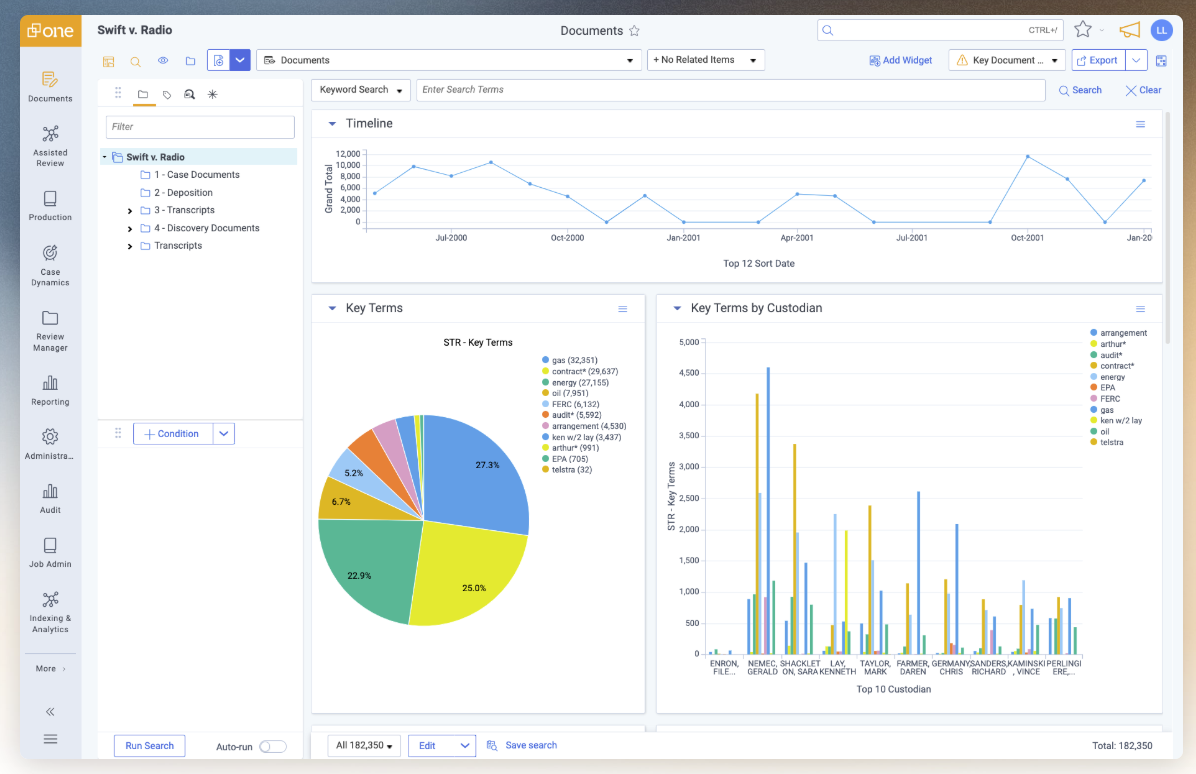
Source: Relativity.com
Known for its ability to handle massive data sets, RelativityOne offers flexibility for teams that must review, search, and produce documents under tight deadlines.
The platform also supports information governance and compliance, which makes it valuable for organizations that deal with sensitive or regulated data.
With its strong infrastructure and advanced features, RelativityOne has become a go-to choice for teams needing a complete system that covers everything from early case assessment to final production.
Best Features
- Early case assessment: Helps attorneys quickly filter large data sets to focus only on the most relevant information before moving deeper into review.
- Artificial intelligence: Uses predictive coding and machine learning to speed up document categorization and review.
- Information governance: Offers tools for monitoring, securing, and organizing data across departments and cases.
- Flexible document production: Built-in features simplify how teams prepare and produce documents for litigation or regulatory matters.
- Global scalability: Designed for corporations and firms handling cases across multiple regions and jurisdictions.
2. Nextpoint
Nextpoint is a cloud-based software built for eDiscovery and trial preparation, designed to support law firms, corporations, and even government agencies that want a more affordable option than larger enterprise systems.
Unlike many complex tools, it aims to give attorneys practical case management features without overloading them with unnecessary steps.
Source: G2
One of the standout parts of Nextpoint is its “digital warroom,” where legal teams can organize exhibits, depositions, and evidence for hearings or trials. This makes it easier to shift from discovery into actual case presentation, a step often overlooked by other platforms.
Nextpoint is frequently mentioned among Everlaw alternatives because of its flexible pricing and approachable design. While it may not have every advanced feature that large-scale systems offer, it delivers the essentials in a way that’s easy to adopt.
Best Features
- Digital warroom: Provides a dedicated space for organizing exhibits, depositions, and trial evidence so attorneys can move smoothly from review to case presentation.
- Cloud-based software: Ensures secure access to documents from any location, which is especially valuable for distributed teams and remote collaboration.
- Affordable pricing models: Offers subscription plans that fit the budgets of small and mid-sized firms without sacrificing core functionality.
- Simple uploads and reviews: Allows fast data processing with drag-and-drop tools, making it easy to start new matters quickly.
- Case management tools: Combines discovery and trial preparation features to give attorneys a single platform for handling the full litigation process.
3. DISCO Ediscovery
DISCO Ediscovery is a modern litigation platform designed to simplify how attorneys and corporate teams handle document review.
Positioned as one of the strongest Everlaw competitors, it focuses on speed, automation, and a user-friendly design that appeals to firms of all sizes.
Source: G2
When clients and legal teams need to analyze large volumes of data quickly, DISCO provides a clear advantage by reducing the time spent on manual review.
How Everlaw compares to DISCO often comes down to usability. While Everlaw has a broad set of features, DISCO emphasizes a faster learning curve and automated tools that assist attorneys in organizing and reviewing evidence.
Overall, it has built a reputation in the market as a platform that balances advanced capabilities with practical design, which is why many other users highlight it as an accessible alternative.
Best Features
- Fast data analysis: Built to analyze and filter massive data sets quickly to make reviews less time-consuming.
- AI-assisted review: Uses automation to categorize, tag, and prioritize documents, which helps focus on the most important files.
- Transparent pricing: Offers clear cost structures that make budget evaluation simpler for law firms and corporate teams.
- Client-focused tools: Designed to help attorneys collaborate with clients and colleagues during review and production.
- Free demo available: Firms can test the platform before committing, so they have a chance to compare features against Everlaw and other alternatives.
4. Logikcull
Logikcull is a self-service eDiscovery platform built to help law firms, business teams, and government organizations manage discovery without heavy IT involvement.
It has become one of the more popular Everlaw alternatives because it combines automation with affordability, which can give attorneys an efficient way to handle cases from start to finish.
Source: G2
Logikcull is typically used for smaller matters where teams want a fast way to upload data, apply filters, and prepare documents for review or production. Its design focuses on reducing the risks of manual handling by automating repetitive steps.
This makes it useful for firms or in-house counsel who need a straightforward solution to serve both litigation and compliance needs.
Best Features
- Automated uploads: Users can drag and drop files directly into the system, which speeds up the start of any project.
- Smart filtering and analytics: Built-in analytics help teams quickly find relevant material while cutting down on unnecessary review.
- Legal hold requests: Provides tools for issuing and tracking a request to preserve data to help protect against evidence loss.
- Cost control features: Offers predictable pricing and keeps details transparent, so firms avoid billing surprises.
- Data security and protection: Designed to safeguard sensitive information while meeting the compliance needs of both firms and businesses.
5. Nuix Neo Discover
Nuix Neo Discover takes a different approach compared to many of the other Everlaw competitors.
Instead of being designed only for law firms, it has its roots in digital forensics and compliance, which makes it a strong option for government investigations and regulated industries.
This background gives it a unique appeal for teams that need more than simple document review; they need a tool that can process complicated data and keep up with strict oversight requirements.
Source: G2
Unlike other cloud solutions for law firms, Nuix offers both cloud and on-premise deployment. That flexibility is important for organizations that prefer to keep sensitive data within their own infrastructure. It also means firms with specific security policies aren’t locked into one way of working.
While Nuix may require more training than lighter tools, the trade-off is a system that can handle massive volumes of material, manage compliance, and support litigation projects with forensic-level precision.
Best Features
- Deployment flexibility: Choose between cloud hosting and on-premise systems depending on security and compliance requirements.
- Forensic-grade processing: Handles diverse file formats, making it suitable for investigations and complex litigation.
- Advanced search tools: Powerful filtering and searching across emails, chats, and structured or unstructured data.
- Compliance support: Designed to meet standards for regulated industries and government oversight.
- Case-ready output: Prepares material efficiently for review, analysis, and submitting evidence.
Replace Expensive eDiscovery Solutions with Briefpoint’s Autodoc
Choosing between Everlaw competitors often comes down to what your team values most, which might include scalability, pricing, compliance, or usability.
Each of the solutions above helps legal professionals make sense of overwhelming volumes of data. But once that data is reviewed and evidence is ready, the real work of litigation continues: drafting discovery responses, motions, and pleadings.

Many attorneys still spend hours repeating the same steps across different cases, and it takes away from the time that could be spent on higher-value work.
Briefpoint bridges that space. It doesn’t replace your eDiscovery platform but works alongside it. After documents are processed and reviewed, Briefpoint and its Autodoc technology can transform that information into fully drafted litigation documents in minutes.
Want to learn more? Book a demo with Briefpoint today to see how it works alongside your eDiscovery tools!
FAQs About Everlaw Competitors
What is the market share of Everlaw?
Everlaw has seen steady growth in the eDiscovery market, particularly among law firms and government agencies, though its exact market share isn’t publicly disclosed.
Is Everlaw a unicorn?
Yes. Everlaw reached unicorn status after securing funding that placed its valuation above $1 billion.
Is Everlaw a good company?
Many users rate Everlaw highly for its document review tools and user experience, though some law firms cite pricing and complexity as concerns.
How do legal teams manage document review more efficiently?
Most legal teams rely on eDiscovery software with built-in automation to make document review faster and reduce human error during data processing.
Why does data processing matter for law firms?
Law firms often handle large volumes of case files. Strong data processing tools help them sort, filter, and prepare documents without wasting time or money on manual work.
The information provided on this website does not, and is not intended to, constitute legal advice; instead, all information, content, and materials available on this site are for general informational purposes only. Information on this website may not constitute the most up-to-date legal or other information.
This website contains links to other third-party websites. Such links are only for the convenience of the reader, user or browser. Readers of this website should contact their attorney to obtain advice with respect to any particular legal matter. No reader, user, or browser of this site should act or refrain from acting on the basis of information on this site without first seeking legal advice from counsel in the relevant jurisdiction. Only your individual attorney can provide assurances that the information contained herein – and your interpretation of it – is applicable or appropriate to your particular situation. Use of, and access to, this website or any of the links or resources contained within the site do not create an attorney-client relationship between the reader, user, or browser and website authors, contributors, contributing law firms, or committee members and their respective employers.
5 Top Legal Document Creation Software for Modern Practices
5 Top Legal Document Creation Software for Modern Practices
Legal work has always revolved around documents. But the way those documents are created hasn’t kept up with the demands on modern legal teams.
Copying language from old files, fixing formatting issues, and other archaic methods like these take time that most firms no longer have. And the more matters a team handles, the heavier that workload becomes.
That pressure is why legal document creation software has become so widely adopted. These platforms help lawyers move past repetitive drafting and create consistent, accurate files in a fraction of the time.
In this guide, we’ll break down what legal document creation software actually is, how it helps legal teams work more efficiently, and which platforms stand out today.
You’ll also see options that support litigation workflows, contract-heavy practices, and even full case management to give you a clear picture of which tools might fit your needs.
What is Legal Document Creation Software?
Legal document creation software (often called legal document automation software or legal document assembly software) helps law firms and legal teams handle the document creation process with less manual effort.
Contrary to popular belief, it’s not limited to writing from scratch. These tools can also draft contracts, review complex legal documents, and manage approvals, edits, and e-signatures in one system.
Here’s what they often cover:
- Drafting contracts, pleadings, discovery requests, and forms
- Pulling client or case data directly into documents
- Reviewing agreements with AI tools that flag issues
- Keeping everything organized with version control and secure storage
According to the 2024 ABA Legal Technology Survey, nearly 30% of law firms reported using AI-powered tools for legal work—up from just 11% the year before. The biggest reason cited was efficiency, with most firms saying these tools save valuable time.
For many firms, legal document creation software is now less of a nice-to-have and more of a practical step toward handling documents faster and with fewer errors.
Top 5 Legal Document Creation Tools
There are plenty of legal document creation software options on the market, each built with different strengths. Some focus on litigation drafting, others on contract workflows, and some are designed for firms that need full case management.
To give you a clear picture, we’ll look at five tools that represent a variety of use cases and applications:
1. Briefpoint
Briefpoint is document automation software built for litigators who are tired of spending hours drafting discovery documents by hand. Instead of retyping language in Microsoft Word or worrying about data entry errors, you can let Briefpoint handle the repetitive parts of the job.
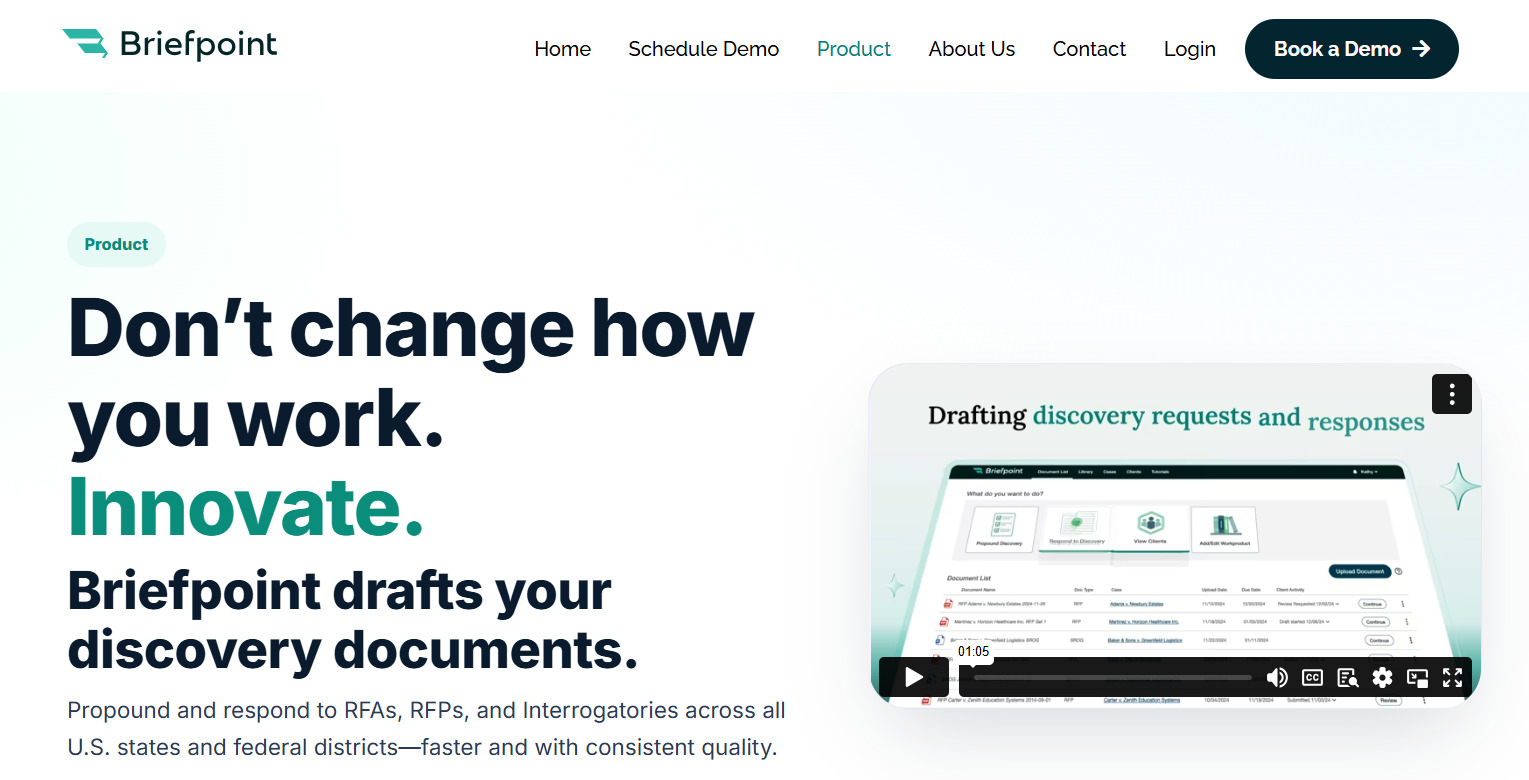
It creates requests for production (RFPs), requests for admission (RFAs), and interrogatories for every U.S. state and federal district, all in just a few clicks.
Here’s how it works: Upload a complaint, and Briefpoint can generate up to 70 targeted requests in under three minutes. The language is objection-aware, so it rewrites requests to avoid ambiguity, compound structure, or overbreadth.
If you’re responding to discovery, the brand new Autodoc feature steps in. It recognizes the court, parties, and request type, then suggests standardized objections and responses you can edit before exporting straight to Word. Join the waitlist now.
Best Features
- Propound discovery: Turn a single complaint into tailored interrogatories, RFAs, and RFPs in minutes, complete with jurisdiction-specific formatting.
- Autodoc automation: Respond to discovery requests instantly with AI-suggested objections and page-level citations.
- Reusable templates: Apply firm-approved objections, definitions, and language across matters so your team stays consistent.
- Error reduction: Eliminate common mistakes through structured input and automated drafting.
- Jurisdiction-ready formatting: Automatically generate captions, numbering, definitions, and instructions that follow state and federal rules.
- Microsoft Word export: Get editable files that are clean, properly formatted, and ready for final touches.
- Security compliance: SOC 2 certified and HIPAA compliant with full encryption, keeping client data safe at every step.
Book a demo today and see how much time you can save on discovery drafting.
2. Clio Draft
Clio Draft, formerly known as Lawyaw, is part of the Clio ecosystem and gives legal professionals an easy way to handle legal drafting inside their existing workflow.
It combines access to jurisdiction-specific forms with smart templates that save time and keep files consistent.
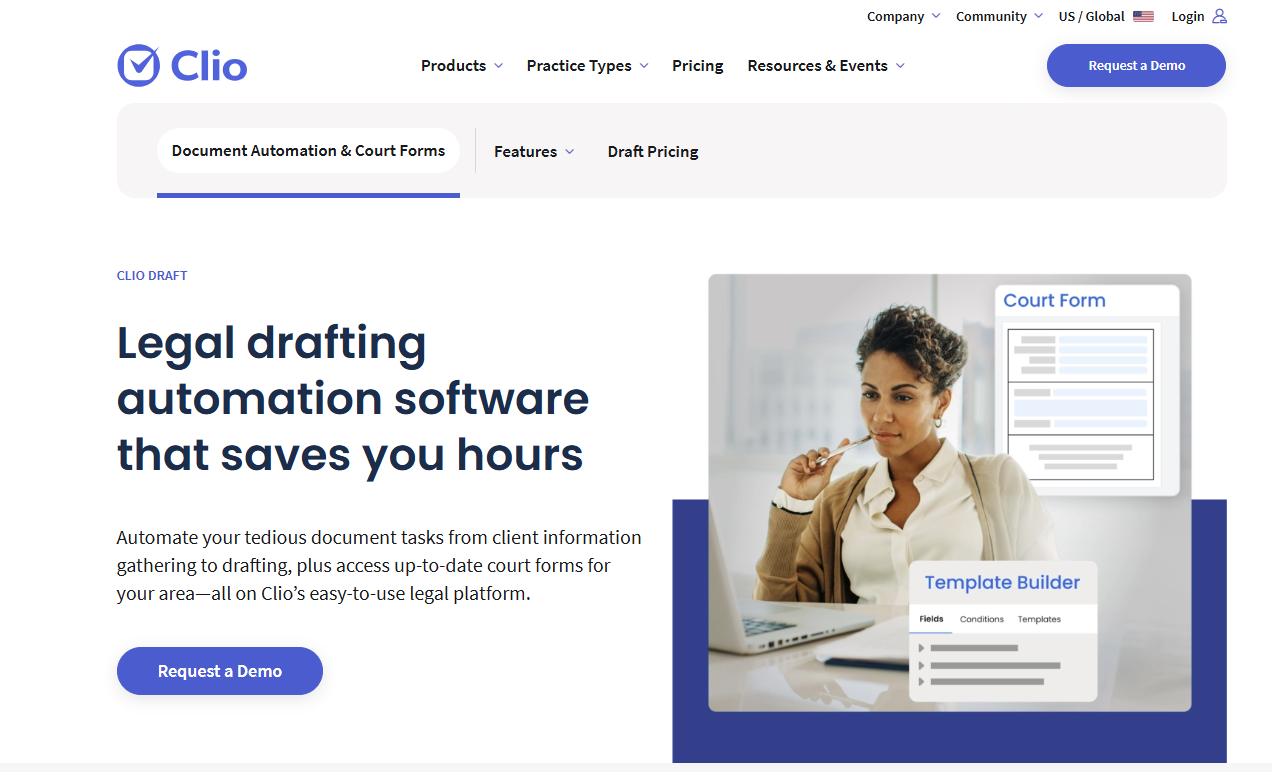
Source: Clio.com
And because it integrates with Clio Manage, attorneys can pull client and case details directly into templates, which speeds up legal document generation and reduces manual entry.
The result is compliant documents that are stored, organized, and easy to find through Clio’s legal document management software.
Best Features
- Smart templates: Reuse templates across cases to cut down on repetitive drafting.
- Legal document generation: Quickly create pleadings, motions, and contracts with automation.
- Compliant documents: Access official state and federal forms to stay aligned with requirements.
- Document management: Keep files stored, organized, and accessible within Clio.
3. Docupilot
Docupilot is flexible legal document drafting software that helps firms build custom document templates for everything from contracts to client intake forms.
So, rather than reworking the same text over and over, attorneys can set up templates once and use them to create documents automatically. This reduces the risk of human error while keeping files consistent across matters.
Source: G2
One of Docupilot’s strengths is handling complex documents with conditional logic. Clauses can appear or disappear based on case details, which makes it easier to generate documents that fit each client without starting from scratch.
Firms with a large library of legacy documents can also adapt them into templates and bring older files into modern document workflows.
Best Features
- Document templates: Build reusable templates for contracts, forms, and agreements.
- Generate documents: Automate the creation of routine files with data pulled from case details.
- Handle complex documents: Apply conditional logic so content changes based on client or case needs.
- Client intake forms: Collect information once and have it flow directly into documents.
- Legacy documents: Convert existing files into templates to modernize drafting workflows.
4. Filevine
Filevine combines case management with automated document drafting that helps firms produce accurate documents faster.

Source: G2
Attorneys can build custom forms to capture client details and feed them directly into standardized templates. These capabilities can help cut down on repetitive work while keeping language consistent.
Finished files are stored in Filevine’s secure document storage, with support for both Word and PDF documents. Since it connects with existing systems, firms can keep their critical documents organized and accessible while reducing duplication of effort.
Best Features
- Custom forms: Collect client or case details and insert them directly into drafts.
- Automated document drafting: Generate critical files quickly with fewer manual steps.
- Standardized templates: Maintain consistent language across contracts, motions, and family law filings.
- Document storage: Keep files organized, searchable, and secure in one place.
- PDF documents: Export clean, court-ready files in Word or PDF format.
5. DocuSign CLM
DocuSign CLM is a legal document automation software designed for legal teams and large law firms that need more than basic drafting. It’s built around contract lifecycle management, which means it gives firms tools to draft, review, approve, and sign agreements in one system.
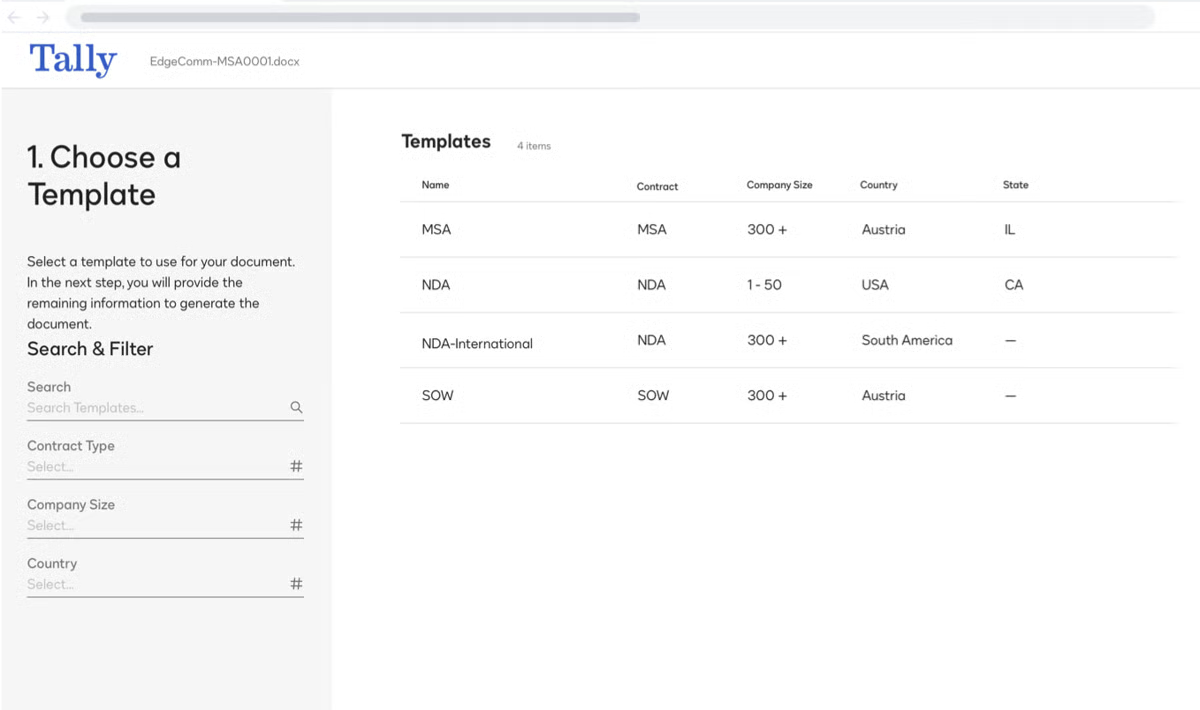
Source: G2
One of DocuSign CLM’s strengths is its built-in electronic signatures, which cut out delays and keep the entire process digital. Contracts move from draft to signed agreement without leaving the platform.
The system also supports seamless integration with CRMs, law office management tools, and other business software, keeping data connected across workflows.
For firms that need advanced features, DocuSign CLM includes audit trails, automated approvals, and version tracking to maintain compliance and accuracy.
Best Features
- Electronic signatures: Collect signatures securely without printing or mailing documents.
- Document automation solution: Draft and manage contracts from start to finish in one platform.
- Automating repetitive tasks: Save time by routing approvals and filling fields automatically.
- Seamless integration: Connects with CRMs, document management, and other existing systems.
- Advanced features: Gain access to audit trails, version history, and automated approval workflows.
Greater Efficiency Starts with Smarter Document Automation
Manual drafting takes time that most legal teams don’t have. How much time does your team spend fixing formatting, copying text from old files, or drafting objections line by line? Those small tasks add up quickly and can take attention away from higher-value work.
Now, the second question is: how much more could your team get done if the drafting process moved faster and left fewer chances for mistakes?
That’s the gap legal document creation software fills. It automates the routine steps, reduces errors, and produces accurate, consistent documents in less time. In other words, it turns drafting from a time sink into a reliable part of your process.
Briefpoint was designed specifically for this. It generates discovery requests and responses in minutes, uses objection-aware language, and formats everything to meet state and federal standards.
Plus, with reusable templates and Word exports, it removes the drag of manual drafting while keeping your documents accurate and compliant.
Book a demo with Briefpoint to see how quickly you can shift from manual drafting to a more efficient, reliable process.
FAQs About Legal Document Creation Software
What software is used to write legal documents?
Law firms and legal teams often use a document automation platform to handle drafting. These tools can automatically populate contracts, pleadings, and discovery documents with client information, helping teams create error-free documents across different practice areas.
What is the best document creation software?
The best choice depends on your needs. Some platforms focus on litigation, while others support contract workflows or broader practice areas. Larger firms often prefer solutions with centralized control and features that support compliance, while smaller firms may value easy setup and dynamic templates.
Can ChatGPT generate legal documents?
ChatGPT can draft text, but it does not replace legal expertise. Any AI-generated content should be reviewed by an attorney to avoid legal issues or compliance issues, especially when handling sensitive legal information.
How to create your own legal document?
You can draft a document from scratch in Word or use a document automation platform to generate documents. Many tools offer dynamic templates that let you input client information once and apply it across different documents, saving time and reducing risk.
Is legal document software secure?
Yes. Most platforms use encryption, role-based access, and other safeguards to protect sensitive legal information. They are designed to address data security concerns while also helping firms support compliance with industry standards.
The information provided on this website does not, and is not intended to, constitute legal advice; instead, all information, content, and materials available on this site are for general informational purposes only. Information on this website may not constitute the most up-to-date legal or other information.
This website contains links to other third-party websites. Such links are only for the convenience of the reader, user or browser. Readers of this website should contact their attorney to obtain advice with respect to any particular legal matter. No reader, user, or browser of this site should act or refrain from acting on the basis of information on this site without first seeking legal advice from counsel in the relevant jurisdiction. Only your individual attorney can provide assurances that the information contained herein – and your interpretation of it – is applicable or appropriate to your particular situation. Use of, and access to, this website or any of the links or resources contained within the site do not create an attorney-client relationship between the reader, user, or browser and website authors, contributors, contributing law firms, or committee members and their respective employers.
What In-House Legal Software Can Do That Spreadsheets Can’t
What In-House Legal Software Can Do That Spreadsheets Can’t
You didn’t go in-house to become a document tracker or intake coordinator. But without the right systems, even the most strategic legal work gets buried under admin.
In-house legal software is changing that. These tools are built to match how corporate legal departments actually operate: managing requests from multiple sources, collaborating with business partners, and keeping track of key information across the company.
If your team is still running on patchwork systems, it might be time to rethink how legal work gets done. This guide breaks down what in-house legal software does, how it helps you serve internal clients better, and why it’s becoming essential to staying fast, secure, and competitive.
What is In-House Legal Software?
In-house legal software is designed specifically to support in-house legal teams and corporate legal departments in managing their daily workload.
Unlike software built for law firms, which often focuses on the litigation process or client billing, in-house tools are centered on the internal legal needs of a company.
These platforms are built to help legal teams handle all your legal matters in one place, whether that’s contracts, risk management, or communication with other departments.
Most in-house legal software includes features that support operational efficiency and help teams stay on top of routine tasks. Instead of relying on spreadsheets or email threads, these platforms give legal teams structure, visibility, and more control over their workload.
Common features include:
- Matter management to organize and track internal legal work
- Contract lifecycle management for handling agreements from draft to signature
- Document storage and search to centralize files
- Collaboration tools to connect with other departments
- Reporting dashboards to monitor progress and trends
While some law firms may use similar tools, in-house legal software is typically tailored to the workflows and challenges of internal teams. In other words, these tools give them a better way to manage work across departments and support the broader goals of the business.
Why Use In-House Legal Software?
Here are some of the key reasons in-house legal teams and corporate legal departments choose dedicated software to manage their work:
Centralized Matter Management
If you’re still managing legal work across spreadsheets, inboxes, and random folders, you’re probably not the only one, but there’s a better way to do it.
Centralized matter management lets your legal department keep everything in one place, so you’re not constantly switching tabs or tracking down who has what.
You can open a matter, see what’s going on, find the right documents, and know exactly where things stand. And because it’s all on a secure platform, you don’t have to worry about things slipping through the cracks.
Most tools come with built-in document management systems, so you can stop digging through shared drives. Everything’s tied to the matter it belongs to. It also helps with resource allocation; you can see who’s busy and who has room to take something on.
The real benefit is clarity and seamless communication. Everyone knows where things stand, what needs attention, and where to find the information they need, without extra emails or follow-ups.
Faster Contract Review and Approval
Contracts can pile up quickly, especially when in-house counsel is handling multiple legal requests at once. In-house legal software helps manage contracts more efficiently by organizing the review process and cutting out the usual back-and-forth.
With built-in contract management tools, teams can create workflows that route documents to the right people, track changes, and keep things in motion. Plus, you’ll know exactly where a contract stands.
The result is faster turnaround, fewer bottlenecks, and more time to focus on the work that needs legal judgment.
Improved Cross-Department Collaboration
Legal teams are constantly working with HR, finance, sales, and other departments. Unfortunately, without the right legal tools, that collaboration can turn into endless email chains and version control headaches.
But with modern management software, legal can easily share updates, provide input, and stay in sync with the rest of the business. No need to chase down attachments or clarify which version is final. Everything lives in one place, so it’s easy to track progress and respond quickly.
Better collaboration doesn’t just reduce friction; it supports smoother legal operations, stronger team performance, and helps boost efficiency firm-wide.
Increased Visibility and Reporting
When legal work is spread across tools and teams, it’s hard to see the full picture. Matter management software with built-in reporting helps legal departments connect the dots. This way, you’re not just reacting to tasks, but spotting patterns and making smarter choices.
You can pull up a dashboard and quickly understand:
- What’s stuck and what’s moving
- Which teams are overloaded
- How long common requests actually take
- Where legal is spending the most time
These reports offer valuable insights that go beyond tracking tasks. They help explain legal’s impact and support better business decisions. With clear data on overall performance, you can back up priorities, allocate resources more effectively, and plan with more confidence.
Reduced Reliance on Outside Counsel
Outside counsel can be helpful, but using them for every matter drains both time and budget. In-house legal software gives legal teams the tools to handle more on their own, like contract reviews, compliance tracking, and everyday business partner requests.
With clearer processes and smarter tools, legal professionals can manage tasks that used to require external support. For example, instead of sending a standard contract for outside review, your legal team can handle it internally using pre-approved templates and automated workflows.
This approach helps the organization move faster and keeps the legal function more connected to daily business needs.
Better Compliance and Risk Management
In-house legal software helps support stronger legal processes by offering tools that make it easier to maintain compliance without relying on manual tracking or reminders.
With built-in alerts, approval workflows, and templates, legal teams can stay organized and avoid missed steps. These intuitive platforms make it simple to manage key documents, apply standard language, and track who’s responsible for what, all while keeping sensitive information secure.
Many tools also include features that support data security and audit trails, which help ensure compliance with company policies and regulatory requirements.
By centralizing key tasks and allowing legal teams to move with more control and consistency, software makes compliance feel less like a burden and more like part of the process.
Best Use Cases of In-House Legal Tools
In-house legal software is meant to make your day-to-day work easier. Here’s how legal departments like yours are putting these tools to work:
- Document automation: You can generate discovery documents, NDAs, and other legal documents faster using shared templates and automated workflows. This helps you cut down on repetitive work and reduce errors, especially when handling similar documents at scale.
- Matter tracking: Instead of juggling spreadsheets or chasing updates, you get a clear view of all open matters, task assignments, and upcoming deadlines in one place.
- Legal intake: With a simple self-service form, business teams can submit requests directly to legal, which means no digging through email chains or chasing missing info. You can sort, prioritize, and respond faster.
- Policy and compliance tracking: Set reminders for key deadlines, log actions, and keep records organized so you’re always ready if someone asks for documentation.
- Document management: Store your files securely, control who sees what, and find what you need without searching five different places. It’s clean, simple, and built for how you actually work.
Briefpoint Lets You Focus on What Needs a Lawyer
There’s no shortage of work for in-house legal teams. Contracts, discovery, internal requests, risk reviews—it’s constant. But not every task deserves your full attention. Drafting routine discovery documents shouldn’t be one of them.

Briefpoint is built for in-house teams that need to move quickly without lowering the bar. It automates interrogatories, RFAs, and RFPs, generating drafts you can open, review, and finalize in minutes, not hours.
Plus, you get consistency, speed, and control, without doing the same formatting and language cleanup over and over again.
Some tools promise to reinvent legal work. Briefpoint simply makes the hard parts less painful.
Book a demo and see how much time your team can save when drafting takes care of itself.
FAQs About In-House Legal Software
Who uses in-house legal software?
It’s built for legal departments working inside companies, not law firms. If you’re supporting internal clients, responding to business partners, and handling a mix of contracts, matters, and compliance work, this software helps keep everything in one place.
How does it help with document management?
You can find documents faster by storing contracts, emails, and supporting files in a single system. No more digging through multiple sources to track down the key information you need.
Can it actually improve how legal supports the business?
Yes. With features like reporting tools, legal teams can make data-driven decisions, track trends, and improve how they support other departments. It also helps with seamless collaboration across the company.
What types of tasks can be automated?
The software is especially good at automating routine tasks like intake, approvals, and document generation. It can free up valuable time and save time on work that doesn’t need to be done manually. That directly improves your team’s overall efficiency and reduces risks caused by delays or missing information.
The information provided on this website does not, and is not intended to, constitute legal advice; instead, all information, content, and materials available on this site are for general informational purposes only. Information on this website may not constitute the most up-to-date legal or other information.
This website contains links to other third-party websites. Such links are only for the convenience of the reader, user or browser. Readers of this website should contact their attorney to obtain advice with respect to any particular legal matter. No reader, user, or browser of this site should act or refrain from acting on the basis of information on this site without first seeking legal advice from counsel in the relevant jurisdiction. Only your individual attorney can provide assurances that the information contained herein – and your interpretation of it – is applicable or appropriate to your particular situation. Use of, and access to, this website or any of the links or resources contained within the site do not create an attorney-client relationship between the reader, user, or browser and website authors, contributors, contributing law firms, or committee members and their respective employers.
5 Best Time Management Software For Law Firms in 2025
5 Best Time Management Software For Law Firms in 2025
Managing time shouldn’t feel like a guessing game, but for many law firms, it often does.
According to the 2025 MyCase Legal Industry Report, 55% of firms called time tracking a significant or moderate challenge, which shows how common it is to struggle with capturing billable hours.
Even with plenty of tools available, many lawyers still miss entries, forget tasks, or spend too much time on manual tracking when they could be focused on client work.
That’s why finding the right time management platform matters more than you think. The right tools can help you track time, bill clients, manage tasks, and handle non-billable work in a way that fits your workflow.
In this guide, we’ll cover top software built for legal professionals, plus smart habits that should help you stay on top of your time and make the most of every hour.
What is Time Management Software?
Time management software helps law firms track how they spend their time. It lets lawyers log hours, monitor billable and non-billable work, and create reports for billing and internal review.
For most law firms, it’s a key part of running a profitable business and making sure clients get billed the right way.
Unlike general time tracking tools, which are often used for simple task management or productivity tracking, legal time management software is built with law firm needs in mind. It usually includes features like:
- Billable hour tracking
- Client and matter management
- Trust accounting
- Legal billing compliance
- Reporting for clients and courts
So while general tools might help you clock in and out, legal-focused software helps firms handle the business side of law, keeping records clear, clients informed, and cash flow steady.
Top 5 Management Tools For Legal Pros
Managing time shouldn’t be the thing that slows you down. So, we’ve rounded up some of the best legal time tracking software of 2025. These picks are built for legal work and make it easier to stay organized and get paid.
1. PointOne
PointOne gives law firms a clear view of their time and expenses without piling on extra work. It makes time and expense tracking simple, so lawyers can capture both billable and non-billable hours without the hassle of manual data entry.

Source: PointOne.com
With fewer mistakes and less guesswork, firms end up securing more billable hours that might have been missed otherwise.
Best Features
- Automatic time capture: Tracks work in the background so you don’t have to rely on memory or manual entry.
- Expense logging: Records costs alongside time entries and ties them directly to client matters.
- Billable vs. non-billable tracking: Shows exactly where your hours go, which helps make it easier to understand productivity and billing gaps.
- Detailed reporting: Creates reports for clients, courts, or internal use with just a few clicks.
- Integrations: Connects with billing and accounting software so your time and expenses flow directly into invoices.
2. LawPay
LawPay isn’t a legal timekeeping software on its own, but it works hand-in-hand with billing software and time tracking tools to help law firms get paid the right way.

Source: G2
Built for legal professionals, it makes accepting payments simple, secure, and fully compliant with industry standards. It pairs well with tools that track billable hours and detailed time entries, which gives firms a smooth way to collect payments for their work.
Best Features
- Legal payment compliance: Accept credit card and online payments while meeting legal industry rules.
- Billing software integration: Connect with time tracking and billing tools for a complete workflow.
- Support for detailed time entries: Make it easy to bill clients based on tracked time and expense entries.
- Easy payment options: Let clients pay by credit card, debit, or eCheck.
- Payment tracking: Review payments on a weekly or monthly basis with clear reports.
- Mobile and online access: Accept payments from your office or on the go.
3. Billables.ai
Billables.ai is a lawyer time tracking software focused on helping legal professionals capture every billable minute. It’s designed for accurate time tracking and helps make sure you don’t miss out on hours worked.

Source: Billables.ai
With smart features that suggest entries based on your activity, Billables.ai makes logging time and expenses quicker and easier. You can adjust time entries, link them directly to matters, and pull detailed time reports whenever you need them.
Best Features
- Accurate time tracking: Get smart suggestions for time entries based on your work activity.
- Link time entries directly to matters: Keep your billing organized and connected to each client.
- Track expenses: Log costs alongside time entries for complete billing records.
- Adjust time entries: Edit or update logged time as needed before billing.
- Detailed time reports: Review your billable minutes and time records for clients or internal checks.
- Calendar and email integrations: Capture time based on meetings and emails you’re already handling.
4. MyCase
MyCase is a practice management tool that includes built-in time tracking features for law firms. It helps you track time spent on each task and link it to the corresponding matter, which usually makes billing smoother and more accurate.

Source: G2
MyCase goes beyond time tracking by offering tools for client communication, document handling, and billing, all in one platform.
Best Features
- Time tracking features: Log time spent on tasks directly within the platform.
- Link time to corresponding matter: Keep your time entries organized and tied to the right client or case.
- Practice management tools: Manage cases, billing, documents, and client communication in one system.
- Improving accuracy: Reduce missed hours with easy time entry and tracking built into daily workflows.
- Client portal: Share updates, documents, and invoices with clients securely.
- Billing and invoicing tools: Generate and send bills without leaving the platform.
5. TimeSparrow
TimeSparrow is a lightweight time tracker built for lawyers who want to record billable time with less manual effort. It makes it easy to track tasks, log hours, and manage billable work without getting in the way of your day.

Source: TimeSparrow.com
With smart tools for tracking and reviewing entries, TimeSparrow helps lawyers ensure accuracy and avoid lost revenue from missed billable time.
Best Features
- Simple time tracker: Quickly capture billable time with easy-to-use tracking tools.
- Email-based time entry: Log time by sending an email; no need to open the app.
- Track billable tasks: Connect each time entry to a client or matter for clear records.
- Ensure accuracy: Review and adjust entries before billing.
- Mobile-friendly access: Track time on the go from any device.
- Helps prevent lost revenue: Makes sure your billable hours are always recorded.
Best Time-Saving Strategies For Legal Professionals
Using the right tools is a great start, but smart time management doesn’t stop there. Once you’ve got your software in place, adding a few good habits can make a big difference.
Here are some practical ways legal professionals can save time and get more done without adding stress.
Track Time Daily
Logging your hours every day lets you stay on top of billable work and avoid missed entries. Waiting until the end of the week often means guessing or forgetting key details, which easily leads to problems when billing clients.
Tools that let you run up to three timers at once make it easier to track multiple tasks without losing track of time. If you’re using manual time tracking, setting a daily reminder can help you build the habit.
This simple practice not only saves time later but also helps you send accurate invoices and avoid billing issues.
Review Weekly Reports
Checking your time reports every week helps you spot patterns in how you work and how much time you spend on each task. With tracking software for lawyers, you can see both billable and non-billable time at a glance, so it’s easier to see where your efforts go.
Regular reviews help you find tasks that take longer than they should or work you’re doing without billing. This habit gives you a better handle on your time and allows you to make smarter business decisions when it comes to billing, staffing, and workload planning.
Automate Billing Tasks
Billing can be one of the most time-consuming parts of running a law firm. Using legal billing software takes a lot of that work off your plate by handling tasks you don’t need to do by hand. This not only saves time but also helps you get paid faster and increase law firm profitability.
It’s especially helpful for fixed fee matters, where keeping track of time spent versus fees earned is key.
Tasks you can automate include:
- Sending invoices on a set schedule
- Tracking payments and sending reminders
- Applying payments to client accounts
- Generating reports for billing and collections
- Managing billing for fixed fee matters and hourly work
Use Templates
Templates make everyday tasks quicker by giving you a ready-made starting point. Instead of writing the same email or setting up a new invoice from scratch each time, you can pull up a template and fill in the details. This saves time and keeps your documents consistent.
For example, you might have a standard retainer agreement or a client update email that only needs a few quick edits before sending.
Limit Distractions
It’s hard to stay focused when emails, messages, and alerts keep popping up. Setting aside blocks of time for focused work lets you handle important tasks without constant interruptions.
You can mute non-urgent alerts, close unused tabs, and let others know you’re working on something that needs your full attention. Even an hour of distraction-free time each day can help you get more done and avoid falling behind on billable work.
Batch Similar Tasks
Switching between tasks like writing, client meetings, and phone calls can break your focus and waste time. Grouping similar tasks together (also called batching) helps you stay in the zone and work faster.
For example, you can block off an hour each morning just for client meetings or phone calls, then spend the next block on research or drafting legal documents.
This way, you’re not jumping back and forth between jobs, which saves time and helps you work more smoothly throughout the day.
Take Advantage of AI Tools
If you’re not using legal AI tools yet, now’s a good time to start. They’re built to take care of tasks that eat up your day, like time tracking, billing, and legal document drafting.
For instance, AI can suggest time entries based on your calendar or emails, so you’re not stuck logging everything by hand.
Here are other things AI tools can help you with:
- Suggesting time entries you might’ve forgotten
- Creating invoices from tracked time automatically
- Reviewing contracts and flagging important details
- Managing documents
- Sorting billing records with less effort
Remember: AI tools won’t take over your work, but they can definitely help you save time and focus on your clients.
Get More Done with Briefpoint
Choosing the best time management software means finding tools that help you bill smarter, manage tasks with less hassle, and cut down on the work that slows you down.
Paired with smart habits like reviewing reports, using AI tools, and batching tasks, the right software can make a real difference in how smoothly your practice runs.

But even with good tools in place, some tasks still take more time than they should. This is where Briefpoint can become a huge edge for your firm. Its AI-powered document automation software takes care of drafting work that often drags out your day and overall litigation process.
With Briefpoint, you can prepare these docs in minutes:
- Interrogatories
- Requests for production
- Requests for admission
You’ll spend less time on manual edits, review documents faster, and have more time for more important litigation work. And because it fits right alongside your time tracking and billing tools, it helps you make the most of every hour.
If you’re looking to optimize your litigation workflow with document automation, book a demo today.
FAQs About Time Management Software for Law Firms
What is the best legal time tracking software for law firms?
The best legal time tracking software helps you log hours easily, avoid missed billable time, and track both billable and non-billable tasks. Tools like Bill4Time, MyCase, and Billables.ai are popular choices because they offer simple time entry, billing features, and detailed reports.
What software do most law firms use?
Many law firms use a mix of time tracking, billing, and practice management tools. Popular options include Bill4Time, MyCase, and LawPay, as they help firms track billable hours, handle non-billable tasks, and manage billing in one place. Some firms also add AI tools like Briefpoint to cut down on document drafting.
What is the best LMS for law firms?
When law firms look for a Learning Management System (LMS), they often want tools that offer legal-specific training, compliance courses, and easy tracking for other users in the firm. Options like Lawline and LearnLex are built with legal professionals in mind, offering CLE tracking and firm-wide learning tools billed annually for budget control.
What is the best task management software for lawyers?
Task management tools like MyCase and Clio Manage are often recommended because they combine task tracking with billing features. These platforms help you stay on top of deadlines, manage non-billable tasks, hit your billable targets, and ultimately make more money, all without juggling spreadsheets or multiple apps.
What is the best case management software for law firms?
Top case management software includes tools like MyCase, PracticePanther, and Clio. These platforms help manage client files, deadlines, billing, and communication in one system. They’re a good fit for firms that want everything in one place without the need to rely on manual spreadsheets or separate billing tools.
The information provided on this website does not, and is not intended to, constitute legal advice; instead, all information, content, and materials available on this site are for general informational purposes only. Information on this website may not constitute the most up-to-date legal or other information.
This website contains links to other third-party websites. Such links are only for the convenience of the reader, user or browser. Readers of this website should contact their attorney to obtain advice with respect to any particular legal matter. No reader, user, or browser of this site should act or refrain from acting on the basis of information on this site without first seeking legal advice from counsel in the relevant jurisdiction. Only your individual attorney can provide assurances that the information contained herein – and your interpretation of it – is applicable or appropriate to your particular situation. Use of, and access to, this website or any of the links or resources contained within the site do not create an attorney-client relationship between the reader, user, or browser and website authors, contributors, contributing law firms, or committee members and their respective employers.
7 Examples of AI in Law Firms Improving Daily Practice
7 Examples of AI in Law Firms Improving Daily Practice
Walk into almost any law office today and you’ll see the same picture: stacks of documents, full inboxes, and lawyers who spend as much time preparing work as they do practicing law.
The legal profession has always balanced expertise with process, but the process side often wins the battle for time.
Today, however, artificial intelligence (AI) is quietly reshaping the workflow. Not with flashy promises, but with practical support that trims hours off the parts of the job no one went to law school for.
And the firms leaning into these tools aren’t chasing a trend. They’re making a trade: fewer late nights buried in paperwork, more focus on strategy, clients, and the details that decide outcomes.
In the sections ahead, we’ll look at how law firms are putting AI to work, the tasks it’s taking off lawyers’ plates, and the tools that are shaping daily practice in 2025.
How Are Law Firms Using AI?
According to the Federal Bar Association’s Legal Industry Report, about 31% of legal professionals said they personally used generative AI at work in 2024, and 21% reported firm‑wide implementation of legal-specific AI tools.
That tells you something. Many attorneys are already using AI in their day-to-day work, while firm-wide adoption is still catching up. Why? Often, firms are building trust, setting policies, and choosing tools that fit their workflows before rolling out broadly.
Here’s how AI is helping those who use it:
- Drafting letters or emails: AI takes the load off routine writing.
- Research and summarization: It pulls up relevant case law or condenses documents fast.
- Contract review: AI flags unusual or risky terms in long agreements.
- Client intake and communication: Chatbots and virtual legal assistants handle initial questions or simple forms.
Among users, most report real-time savings, with 65% of law professionals saying they save 1–5 hours weekly just by using AI tools daily. That makes a difference; you get to focus more on strategy, client work, or thoughtful legal analysis instead of routine busywork.
In short, individuals are finding AI useful right now, and as it proves itself, more firms are starting to bring it into the workflow where it fits best.
Best AI-Powered Tools For Law Firms in 2025
Law firms that start using AI often ask the same next question: which tools actually make the work easier? With more options available in 2025, the focus is on tools that fit right into everyday legal tasks and save hours without disrupting the way your team works.
Let’s look at some of the best options:
1. Briefpoint
Briefpoint is an AI-powered document automation software that handles the routine drafting of discovery documents for busy legal professionals.
If you’ve ever spent hours preparing requests for admission, requests for production, or interrogatories—both propounding and responding—Briefpoint takes that workload off your desk.

It automatically generates court‑ready drafts, applies proper formatting, and even builds objections, which gives you more time for the parts of your cases that truly need your attention.
With many law firms already using generative AI to speed up litigation tasks, Briefpoint stands out because it’s built specifically for the legal profession.
Upload a complaint to create a propounded discovery or drop in opposing counsel’s requests to produce organized responses in minutes.
Best Features
- Automated discovery drafting: Generates RFAs, RFPs, and interrogatories for all U.S. states and federal districts.
- Objection and response builder: Suggests objections and organizes client responses efficiently.
- Smart court formatting: Applies captions, case numbers, and local formatting rules automatically.
- Workflow integration: Drag‑and‑drop into your CMS and sync deadlines to your calendar.
- Data security: 100% encrypted, with no client data used to train other AI tools.
Pros
- Cuts discovery drafting time by an average of 87%
- Maintains consistency across objections and formatting
- Reduces manual errors and repetitive typing
- Easy for new users to learn quickly
- Frees up hours for client work or strategy
- Provides 24/7 support for busy legal teams
Briefpoint helps you get discovery off your plate faster. Book a demo to see how quickly your team can turn drafts into ready‑to‑serve documents!
2. Clio
Clio is a legal practice management platform designed to make running your firm less stressful. If your desk is full of case files, deadlines, and client emails, Clio keeps everything in one organized space.

Source: G2
It handles the routine tasks like scheduling, billing, and document storage, while its AI technology helps with legal drafting and workflow automation.
For lawyers looking to boost productivity and keep client communication smooth, Clio is a reliable tool that fits into daily legal services without a steep learning curve.
Best Features
- Case and document management: Stores all client files, deadlines, and case notes in one secure hub.
- AI-assisted document drafting: Speeds up repetitive drafting tasks with smart suggestions.
- Client communication tools: Lets you send updates, schedule meetings, and handle intake securely.
- Time and billing management: Tracks billable hours and generates invoices with ease.
Pros
- Keeps your cases and client interactions organized
- Cuts down time spent on repetitive administrative work
- Makes collaboration easier across your team
- Accessible from desktop or mobile for on‑the‑go work
3. CoCounsel
CoCounsel is an AI software designed to support lawyers with research, drafting, and analysis across different practice groups.
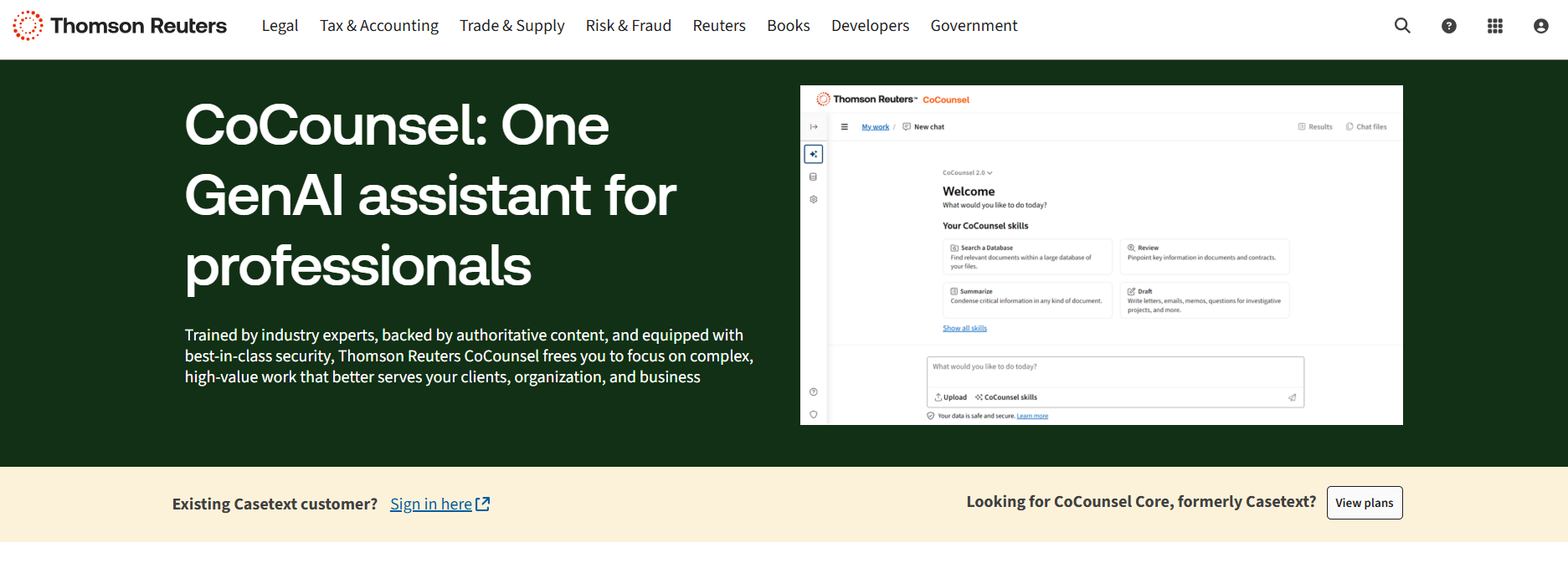
Source: ThomsonReuters.com
If legal work like combing through case law, summarizing complex documents, or preparing early drafts slows your team down, CoCounsel helps you get there faster.
It’s built to boost lawyer productivity by handling routine research and drafting tasks while leaving strategic planning and final judgment to human oversight.
By combining technological advancements with practical workflows, CoCounsel fits into a firm’s daily legal operations without replacing the lawyer’s role.
Best Features
- Rapid legal research: Pulls statutes, case law, and summaries in seconds.
- AI-generated document drafts: Produces first drafts for motions and memos to save time.
- Cross-practice support: Works across multiple practice groups, from litigation to corporate.
- Built-in human oversight: Keeps lawyers in control of every output with easy review and edits.
Pros
- Speeds up research and document prep significantly
- Helps firms allocate more time to client strategy and planning
- Reduces the repetitive, time-consuming side of legal work
- Integrates smoothly with daily workflows in most firms
4. Spellbook
Spellbook focuses on one thing most lawyers deal with constantly: contracts. Reviewing and drafting agreements takes time, especially when you’re handling large volumes or working with standard documents that still need careful attention.
Spellbook brings AI and machine learning into that process to give legal professionals a faster way to spot risks, fill in routine sections, and keep contracts consistent.
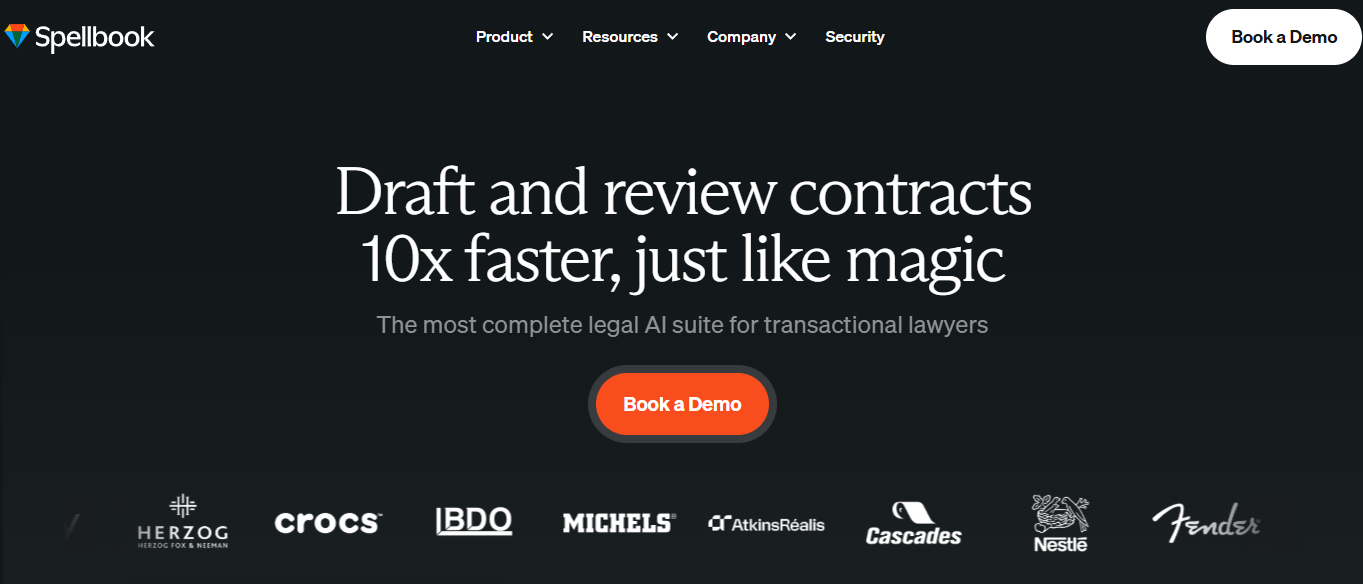
Source: Spellbook.Legal
Instead of moving between platforms, Spellbook works directly in Microsoft Word. It highlights clauses that might need review, suggests language you can approve or adjust, and helps reduce the hours spent combing through repetitive text.
Best Features
- Contract risk detection: Flags clauses that could pose problems or require attention.
- Clause and language suggestions: Provides editable text to handle standard documents faster.
- Microsoft Word integration: Lets you review and draft legal documents without leaving your main workspace.
- Machine learning support: Learns from your edits to improve suggestions over time.
Pros
- Cuts down on repetitive contract review
- Supports faster drafting without sacrificing control
- Keeps all work in the tools lawyers already use
- Helps teams stay consistent across multiple agreements
5. Luminance
Luminance is designed for legal teams that deal with vast quantities of legal documents and need a faster way to manage document review.
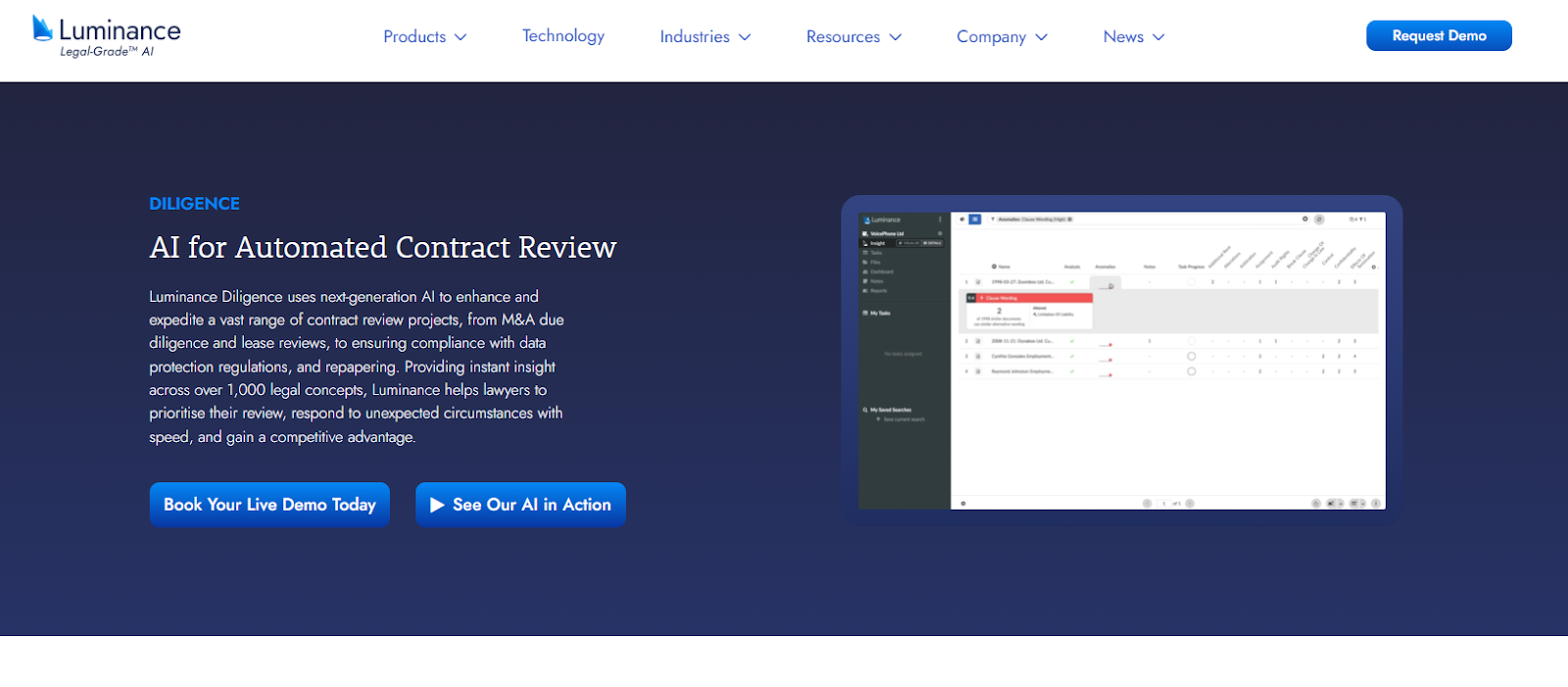
Source: Luminance.com
Combing through contracts, exhibits, and other legal documents for due diligence or compliance can quickly become repetitive and slow down your workflow.
Luminance uses AI systems to identify patterns, highlight key clauses, and organize legal data so you can move through reviews with greater efficiency.
This emerging technology is especially useful during large transactions or investigations where accuracy matters, but time is limited. Rather than manually checking every line, you get clear insights that point you to what needs attention first.
Best Features
- AI-powered document review: Analyzes large volumes of contracts and legal brief materials quickly.
- Key clause detection: Flags unusual or missing terms for faster assessment.
- Legal data organization: Groups related files to simplify due diligence projects.
- Scalable for big cases: Handles vast quantities of files without slowing down your workflow.
Pros
- Speeds up due diligence and large document review projects
- Reduces the most repetitive tasks for legal teams
- Helps identify risks and missing information faster
- Improves efficiency without replacing human oversight
6. Smith.ai
Smith.ai brings new technology to a challenge every firm faces, which is staying on top of client communication. Missed calls or delayed responses can mean lost opportunities, and that’s where a dedicated team paired with AI deployment makes a difference.
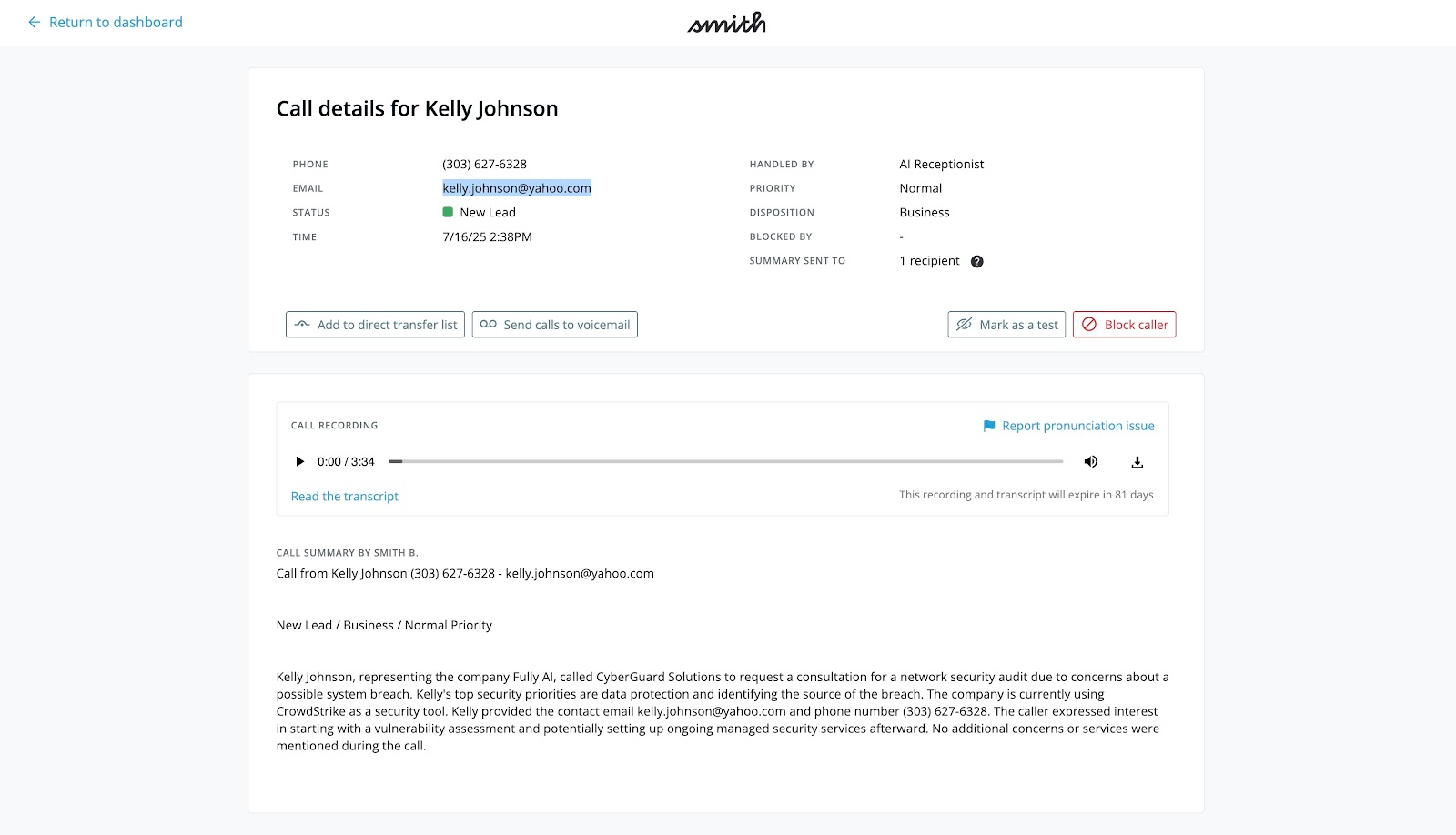
Source: G2
Smith.ai combines live receptionists with AI systems to answer calls, handle website chats, and capture client information around the clock.
For firms in the legal industry, this means no inquiry goes unanswered. Prospective clients get the legal information they’re looking for quickly, and existing clients feel supported without your staff being tied to the phone.
Best Features
- 24/7 virtual receptionist service: Handles calls and chats to capture leads at any time.
- AI-supported intake and screening: Collects and organizes client information for your team.
- Integration with practice tools: Sends details directly into your CRM or case management software.
- Outbound call support: Follows up on leads or reminders without adding to your workload.
Pros
- Keeps firms connected to potential and existing clients day and night
- Reduces interruptions for attorneys and staff
- Makes client intake faster and more consistent
- Useful tool for firms preparing for the future of AI in client communication
7. Everlaw
Everlaw is an eDiscovery and litigation platform that helps law firms and legal departments manage vast amounts of evidence and case material efficiently.

Source: G2
In the legal field, handling documents for tort litigation, investigations, or large corporate cases can be overwhelming without the right tools. But by implementing AI into its workflow, Everlaw turns what used to be a slow, manual review into a more structured and manageable process.
This platform acts as a transformative force for teams aiming for professional excellence while meeting a lawyer’s duty to protect client data. It organizes case files, identifies relevant evidence quickly, and maintains strict data privacy standards.
Best Features
- Advanced eDiscovery review: Filters and analyzes large sets of documents to highlight relevant evidence.
- AI-powered search and tagging: Speeds up finding key details across vast amounts of data.
- Collaboration tools: Lets attorneys, staff, and experts work together securely in one workspace.
- Data privacy and security: Meets strict legal requirements to protect sensitive client material.
Pros
- Handles large, complex litigation processes without slowing your team down
- Speeds up document review and evidence preparation
- Maintains strong data privacy and compliance standards
- Supports lawyers in focusing on strategy over administrative work
Why Briefpoint Leads the Shift in Legal AI
As you can see, AI tools aren’t just conveniences; they’re changing how work gets done in ways that directly affect client service, team efficiency, and a lawyer’s day-to-day life.
That being the case, the firms seeing the most benefit are the ones that pick tools that fit naturally into their workflow and focus on freeing time for higher-value work.

Briefpoint stands out because it solves one of the most time-consuming parts of litigation: discovery drafting.
While other platforms assist with research or document review, Briefpoint gives you back hours by automating the routine parts of propounding and responding to discovery.
It’s a practical step toward adopting AI without losing control of your work product, and it can have a noticeable impact on your team’s schedule and energy.
If saving time on repetitive discovery tasks sounds like a change your firm could use, book a demo today!
FAQs About AI in Law Firms
Will AI take over law firms?
No. AI tools assist with tasks like document review, research, and drafting, but they don’t replace lawyers. Human judgment, strategy, and client relationships remain at the core of legal work.
Is artificial intelligence a threat to lawyers?
AI is more of a support tool than a threat. It handles repetitive tasks, but decisions involving legal strategy, ethical considerations, and client representation still rely on attorneys.
How many law firms are using AI?
Use is growing steadily. Many firms have started with research and document review tools, while larger firms are exploring AI in areas like litigation support, capital markets, and eDiscovery.
Are AI tools safe for handling client information?
Most AI platforms in the legal field are built with privacy and data security in mind. Still, firms should review any tool’s policies to address privacy concerns and confirm it meets their compliance requirements.
Will AI completely replace lawyers in document review?
No. While AI can process and organize vast sets of documents quickly, human oversight is required to confirm accuracy, address nuanced issues, and maintain professional responsibility.
The information provided on this website does not, and is not intended to, constitute legal advice; instead, all information, content, and materials available on this site are for general informational purposes only. Information on this website may not constitute the most up-to-date legal or other information.
This website contains links to other third-party websites. Such links are only for the convenience of the reader, user or browser. Readers of this website should contact their attorney to obtain advice with respect to any particular legal matter. No reader, user, or browser of this site should act or refrain from acting on the basis of information on this site without first seeking legal advice from counsel in the relevant jurisdiction. Only your individual attorney can provide assurances that the information contained herein – and your interpretation of it – is applicable or appropriate to your particular situation. Use of, and access to, this website or any of the links or resources contained within the site do not create an attorney-client relationship between the reader, user, or browser and website authors, contributors, contributing law firms, or committee members and their respective employers.
5 Litigation Management Software Options For Busy Teams
5 Litigation Management Software Options For Busy Teams
Legal work isn’t always spent in courtrooms or client meetings. A surprising amount of time goes to chasing down documents, reformatting drafts, or juggling deadlines across tools that don’t talk to each other.
According to Clio’s Legal Trends Report, lawyers bill just 2.9 hours out of an 8-hour day on average. That’s only 37% of the workday spent on billable tasks—an efficiency gap that adds up fast.
Some of that is inevitable. But a lot comes down to how legal teams manage the day-to-day of litigation. Without the right systems in place, it’s easy to lose valuable time on process instead of progress.
In this guide, we break down the tools built to change that. From discovery automation to centralized case tracking, these litigation management software platforms help legal teams stay organized, meet deadlines, and spend more time on the work that actually matters.
What is Litigation Management Software?
Litigation management software covers a broad category of tools built to help legal teams stay organized during litigation. Some focus on tracking deadlines and filings. Others specialize in automating routine tasks or generating discovery documents.
Depending on the tool, it might support civil litigation cases, internal legal teams, or full-service firms handling dozens of matters at once.
What they all have in common is the goal: making litigation case management less chaotic and more controlled.
Here’s what these tools often include:
- Calendaring for key litigation events and deadlines
- Centralized document and evidence storage
- Progress tracking and task management
- Discovery drafting or automation features
Depending on the needs of your legal team, you might use a tool that handles the entire litigation process or one that focuses on a specific phase like discovery or case tracking. Each type is designed to make legal work more manageable and efficient.
Best Software For Litigation Management
Not sure where to start? We’ve compiled tools that support various aspects of litigation, so you can find the right fit for how your team works.
1. Briefpoint
Briefpoint is a specialized tool designed to help legal professionals reclaim valuable time during the most tedious parts of the litigation process.
Built for busy law firms, it focuses on automating the discovery process—drafting interrogatories, RFAs, and RFPs in a fraction of the time it would take manually.

It’s not a general-purpose platform trying to do everything. It’s built for one thing: helping you get through discovery faster, while still aligning with court rules and filing deadlines.
By removing the need to copy and paste from templates, manually format citations, or triple-check procedural rules, Briefpoint gives litigation teams the ability to focus on strategy.
It’s ideal for in-house teams and law firms that want efficiency without sacrificing accuracy or professionalism.
Best Features
- Automated discovery drafting: Generate tailored interrogatories, requests for admission, and requests for production from complaints in under three minutes.
- Jurisdiction-ready formatting: Automatically applies proper formatting, captions, numbering, and instructions for all U.S. states and federal courts.
- Objection-aware language: Uses artificial intelligence to avoid ambiguity, compound questions, assumptions, and overbroad phrasing when propounding or responding.
- Response drafting assistance: Upload opposing counsel’s discovery and generate consistent, defensible responses using firm-standard objections and suggestions.
- Editable and exportable output: Customize drafts, regenerate variants, and export clean Word files ready for review, signature, and service.
- Secure and private platform: SOC 2 certified, HIPAA compliant, and designed to keep sensitive legal data siloed and protected.
Pros
- Purpose-built for the discovery process
- Saves hours of manual drafting and formatting
- Helps reduce the risk of procedural mistakes
- Keeps litigation teams on track with filing deadlines
- Used by hundreds of firms handling high volumes of discovery
- Makes trial preparation more focused and less administrative
- Gives legal professionals a simple, effective way to manage discovery without learning a whole new platform
See how Briefpoint works today.
2. Filevine
Filevine is a legal software platform designed to support litigation teams, especially at larger firms, managing complex cases. It brings together tools for communication, case tracking, and document management on one centralized platform.

Source: G2
With built-in discovery management features, Filevine helps legal teams stay on top of court documents, deadlines, and ongoing communication. It also reduces time spent on administrative tasks by automating intake, task assignments, and progress tracking.
Best Features
- Document management: Store, organize, and access court documents and evidence securely from one place.
- Case progress tracking: Monitor deadlines, assignments, and outcomes across teams and matters.
- Seamless integration: Connects easily with tools like Outlook, Google Drive, and Dropbox to fit into existing workflows.
- Reporting tools: Built-in dashboards provide valuable insights into performance and workloads.
Pros
- Designed for litigation-heavy practices and larger firms
- Handles large volumes of data and files
- Custom workflows help teams adapt to different case types
3. Clio
Clio is an essential tool for litigation teams looking to manage case files, deadlines, and client communications in one place. Designed for legal professionals across practice areas, it helps firms stay organized and responsive throughout the litigation case lifecycle.

Source: G2
From tracking court dates to managing electronically stored information (ESI), Clio brings together critical details that matter most during litigation. It also offers automated reminders to keep teams aligned on timelines and deliverables.
Best Features
- Case file management: Keep documents, notes, and court records organized and accessible.
- Automated reminders: Reduce the risk of missed court dates or critical deadlines with smart alerts.
- Client communication tools: Secure messaging and client portals help manage conversations and expectations.
- Calendar and task tracking: Visual tools to assign responsibilities and follow litigation workflows.
Pros
- Easy to use and quick to implement
- Cloud-based access for on-the-go litigation teams
- Helps reduce administrative overload with automation
4. Smokeball
Smokeball is a cloud-based legal software designed to help litigation teams streamline daily operations and improve visibility into active matters.
It combines document automation, time tracking, and matter management to deliver greater efficiency without adding to your team’s workload.
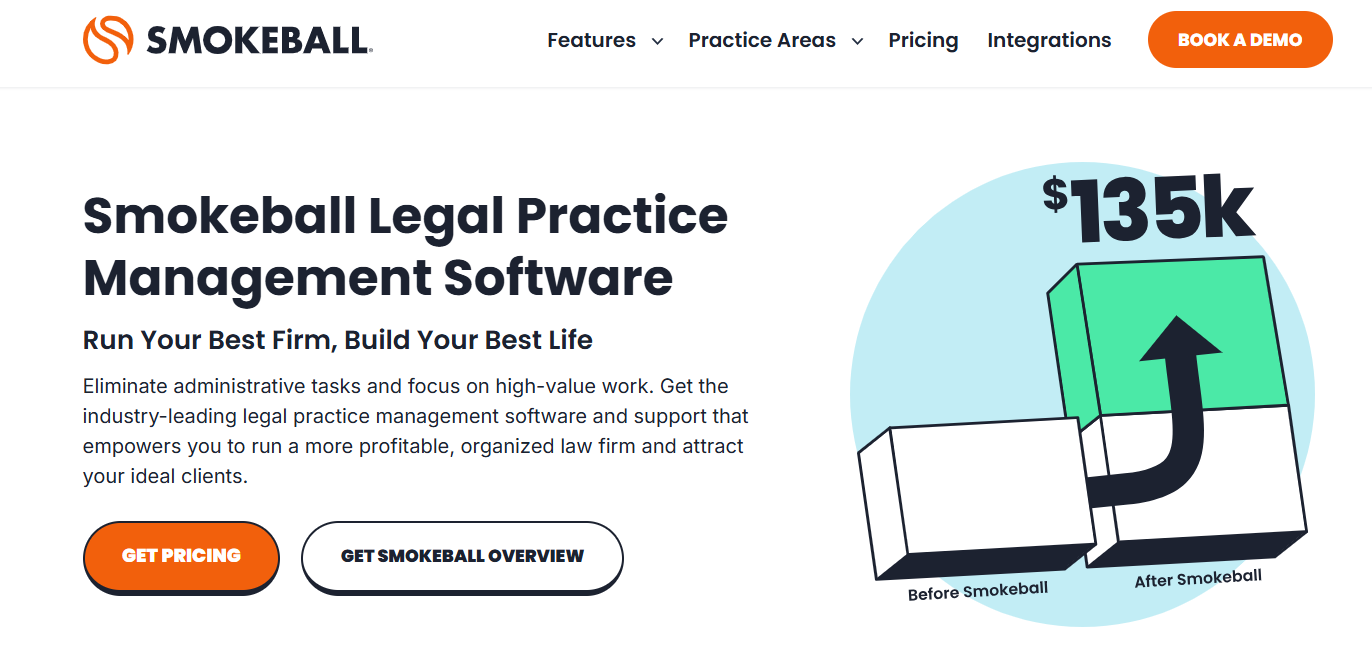
Source: Smokeball.com
With built-in tools to track case progress and manage legal documents securely, Smokeball supports seamless collaboration across staff, even when dealing with sensitive information. Its intuitive interface also helps reduce the learning curve for new users.
Best Features
- Automatic time tracking: Capture time spent on emails, documents, and tasks without manual entry.
- Legal document automation: Create and manage frequently used documents faster using pre-built templates.
- Matter management: Monitor deadlines, communications, and billing activity in one place.
- Expense and legal spend tracking: Get visibility into case-level costs to manage budgets and client reporting.
Pros
- Streamlines repetitive tasks to free up legal teams
- Helps maintain compliance when handling sensitive files
- Built for smaller firms that want legal automation without complexity
5. Lex Machina
Lex Machina is a litigation analytics platform that helps lawyers make smarter, data-driven decisions.
Essentially, it mines millions of court documents to extract key case information, patterns, and outcomes, which can give you a strategic edge when evaluating how to approach a case or assess risk.
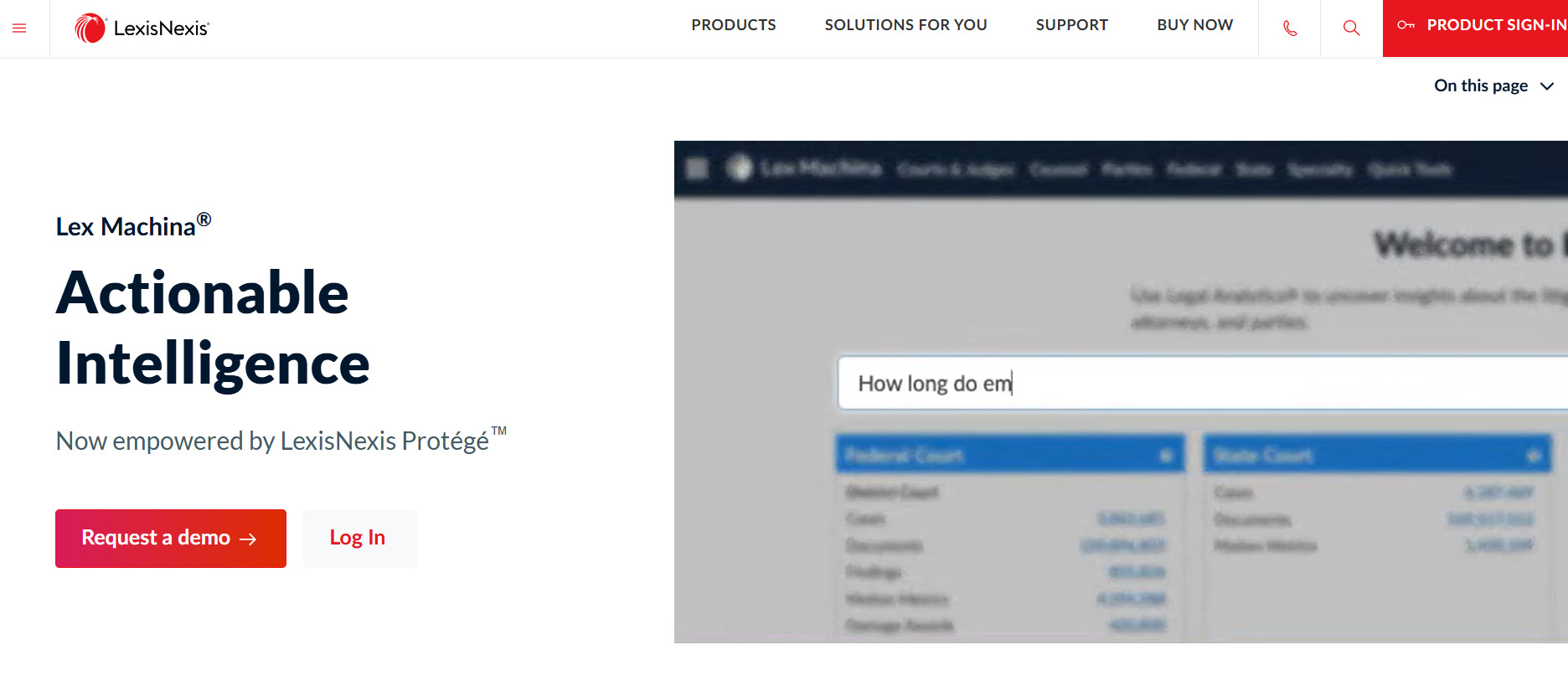
Source: LexisNexis.com
Instead of spending valuable time manually reviewing dockets, legal teams can instantly see how judges have ruled in similar cases, how opposing counsel tends to litigate, and which arguments have historically worked. That means more time for billable work and better preparation across the board.
Best Features
- Analytics for case outcomes: Review win rates, timing, and damages awarded across jurisdictions.
- Judge and opposing counsel profiles: Gain insight into tendencies and litigation history.
- Customizable filters: Zero in on relevant data for specific parties, courts, or case types.
- Visual dashboards: Present complex trends in a clear, easy-to-understand format.
Pros
- Helps lawyers focus efforts where they’re most likely to succeed
- Saves research time and supports a stronger litigation strategy
- Suitable for firms handling complex or high-stakes civil litigation cases
Better Litigation Outcomes Start With Smarter Document Management
When you’re deep into a litigation case, the last thing you need is to waste time repeating the same drafting steps or double-checking formatting rules.
Every minute counts, and so does every document. From tracking deadlines to managing court filings, you need tools that actually help you move things forward.

Briefpoint was built with that in mind. It handles the heavy lifting during discovery, turning complaints into well-structured RFAs, RFPs, and interrogatories in minutes. You stay in control while it takes care of the formatting, phrasing, and local rules.
If discovery still feels like a time sink, it doesn’t have to. Book your Briefpoint demo now and see how much easier litigation management can be.
FAQs About Litigation Management Software
What is the best legal case management software?
The best legal case management software depends on your firm’s size, practice area, and workflow needs. Some attorneys prioritize tools with strong intake process support and document automation, while others look for real-time updates and seamless collaboration tools. Choosing the right litigation management software means identifying a solution that fits your caseload and helps your team stay organized without extra administrative work.
What is legal management software?
Legal management software is a digital platform designed to help attorneys and legal teams handle core tasks such as scheduling, case tracking, document storage, and communications. The key features often include deadline management, client information databases, and collaboration tools that help streamline the litigation workflow from intake to resolution.
What is the most common legal software?
Common legal software includes platforms like Clio, Filevine, and PracticePanther, which cover a wide range of case management needs. These systems offer tools for calendaring, document management, billing, and secure communication, all built to help attorneys save time and reduce risk while managing litigation more efficiently.
Do law firms use case management software?
Yes, most law firms use case management software to centralize files, automate routine tasks, and coordinate across teams. These platforms offer real-time updates, secure access, and features that help attorneys stay focused on legal work without losing track of critical details. Security, scalability, and flexibility are major factors when selecting a solution.
The information provided on this website does not, and is not intended to, constitute legal advice; instead, all information, content, and materials available on this site are for general informational purposes only. Information on this website may not constitute the most up-to-date legal or other information.
This website contains links to other third-party websites. Such links are only for the convenience of the reader, user or browser. Readers of this website should contact their attorney to obtain advice with respect to any particular legal matter. No reader, user, or browser of this site should act or refrain from acting on the basis of information on this site without first seeking legal advice from counsel in the relevant jurisdiction. Only your individual attorney can provide assurances that the information contained herein – and your interpretation of it – is applicable or appropriate to your particular situation. Use of, and access to, this website or any of the links or resources contained within the site do not create an attorney-client relationship between the reader, user, or browser and website authors, contributors, contributing law firms, or committee members and their respective employers.